A mainstay of Toyota SUVs, the RAV4 has now hit its fifth generation. After 25 years, we get an all-new from the ground-up car.
Built on the Toyota New Global Architecture platform, this is the first hybrid Toyota SUV, although we got sent a 2.5-litre non-hybrid to test out. Hopefully we’ll get a hybrid at a later date.
Toyota must be pleased though – the RAV4 made it onto the top ten list for the Car of The Year.
Is the hybrid the only one to get, or is this Adventure model a good option? Time to spend a week behind the wheel.
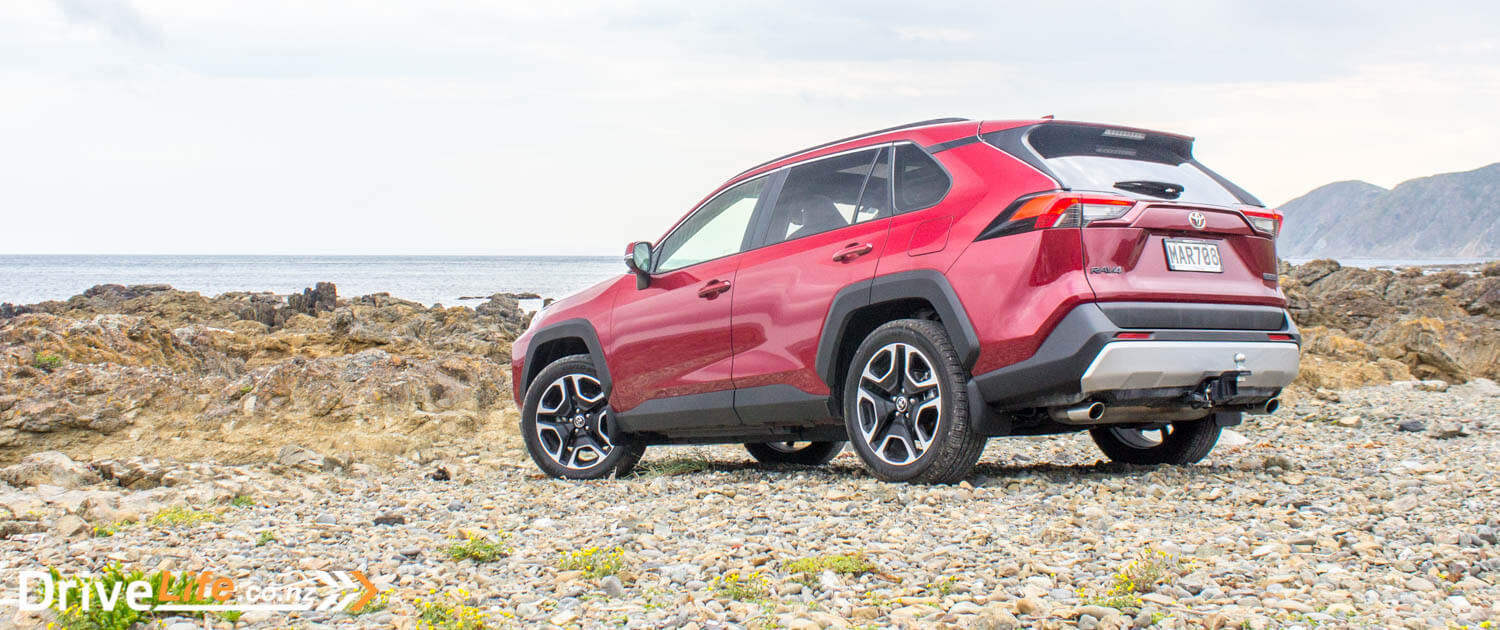
What’s In The 2019 Toyota RAV4 Range?
There’s a total of eight models in the RAV4 range; three are 2.0-litre petrol models, two are 2.5-litre petrol, and there’s three 2.5-litre hybrid models.
The 2.0-litre models come as GX (base), GXL or Limited. You can get the 2.5-litre as a GLX or Adventure (tested here), and the hybrids are GX, GXL and Limited.
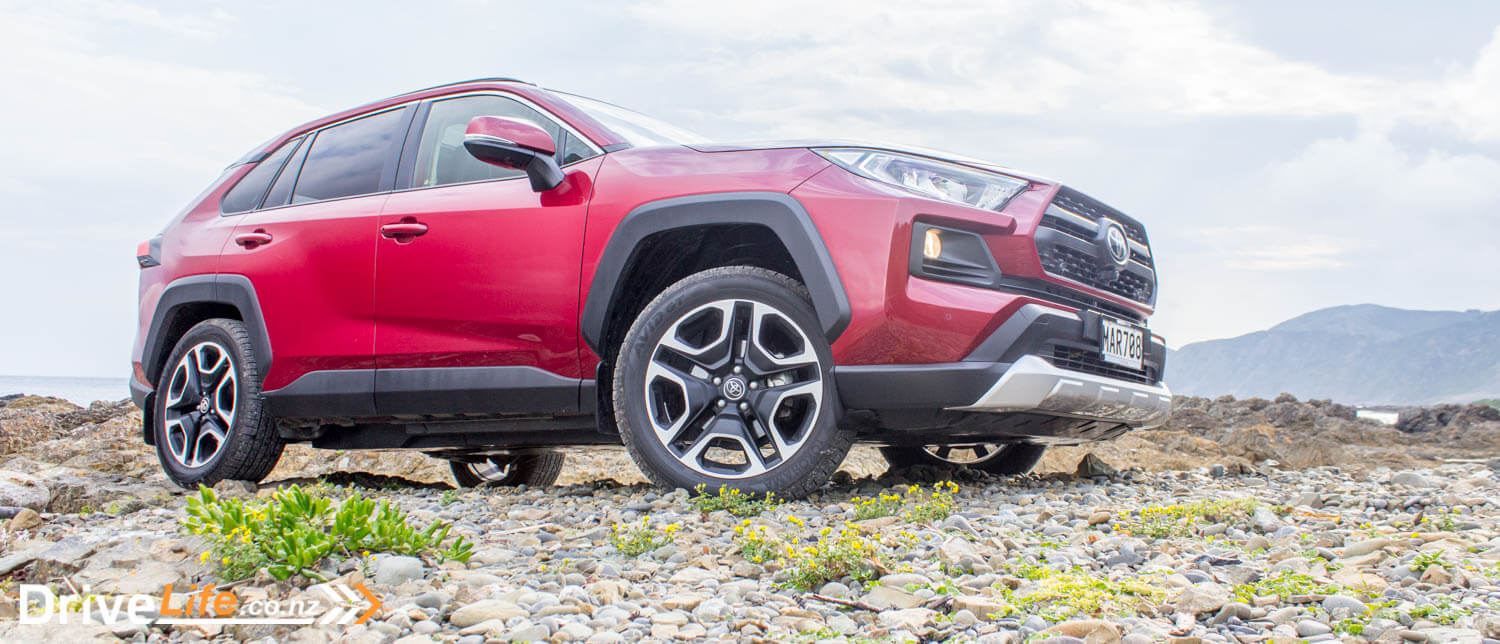
If you opt for the 2.0-litre, that motor will give you 127kW of power and 203Nm of torque. These models are fitted with a CVT automatic with a mechanical start-off gear. All 2.0-litre RAV4s are front wheel-drive only.
Both the new ‘Dynamic Force’ 2.5-litre petrol models are AWD and come with an 8-speed automatic gearbox. That engine manages 152kW of power, and 243Nm of torque.
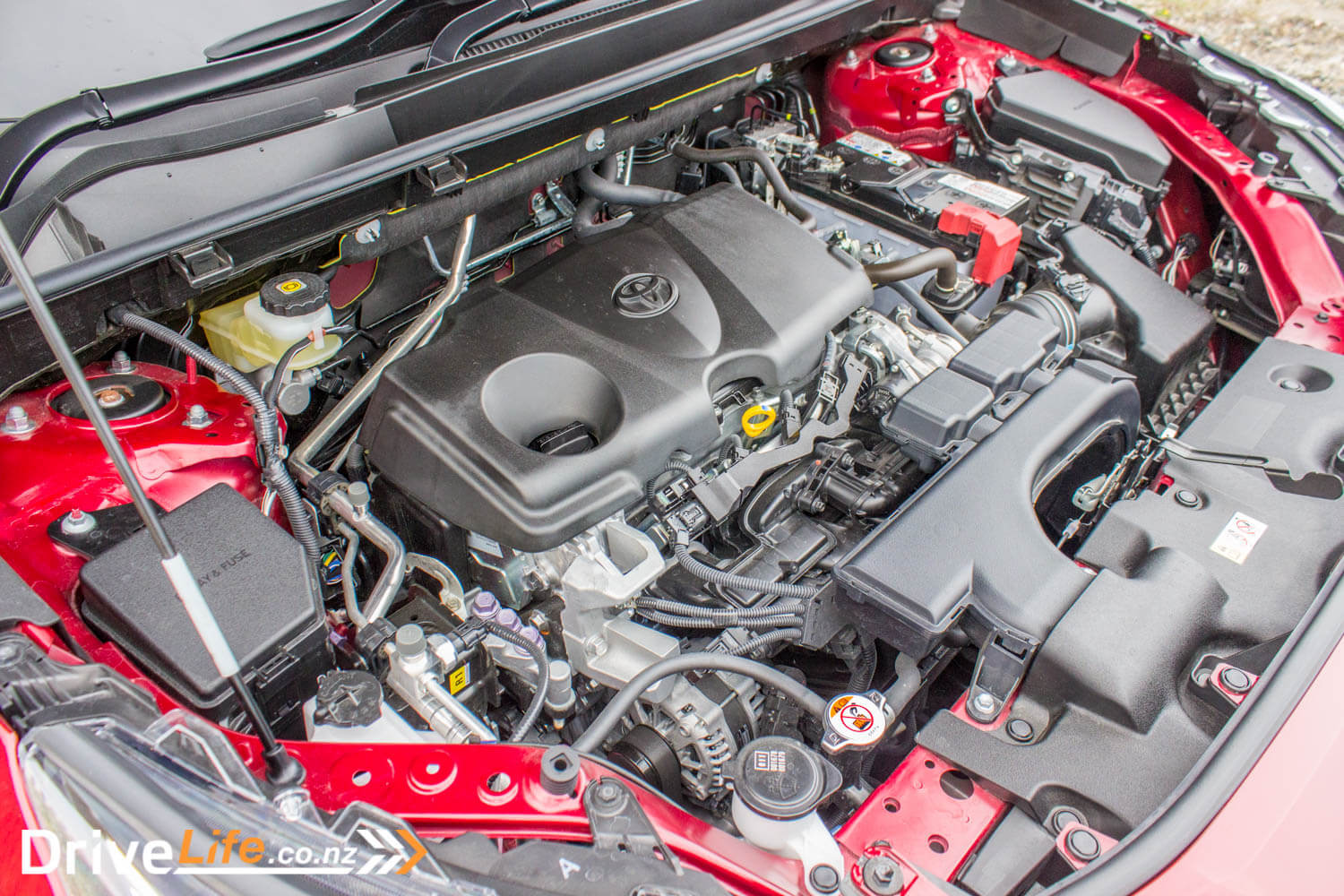
All hybrids are also AWD, run the same 2.5-litre motor and have an electronic CVT transmission, but no mechanical start-off gear. Power is down now to 131kW for the engine and 221Nm of torque. But with the hybrid system added in, your total power available is 163kW. Towing capacity is worth mentioning here. Normally hybrids tow little weight, but the hybrid RAV4 manages 1,500Kg. It’s not an SUV, but in comparison the hybrid Camry can only tow up to 300Kg.
Toyota have loaded the RAV4 with a pretty decent equipment list. As standard, all models have Toyota’s Safety Sense. This includes ACC, pre collision system with autonomous emergency braking (including pedestrian & cyclist detection), road sign assist lane tracing assist and automatic high beams. Also included is blind spot monitoring, rear cross traffic alert, a reversing camera, and front and rear parking sensors.
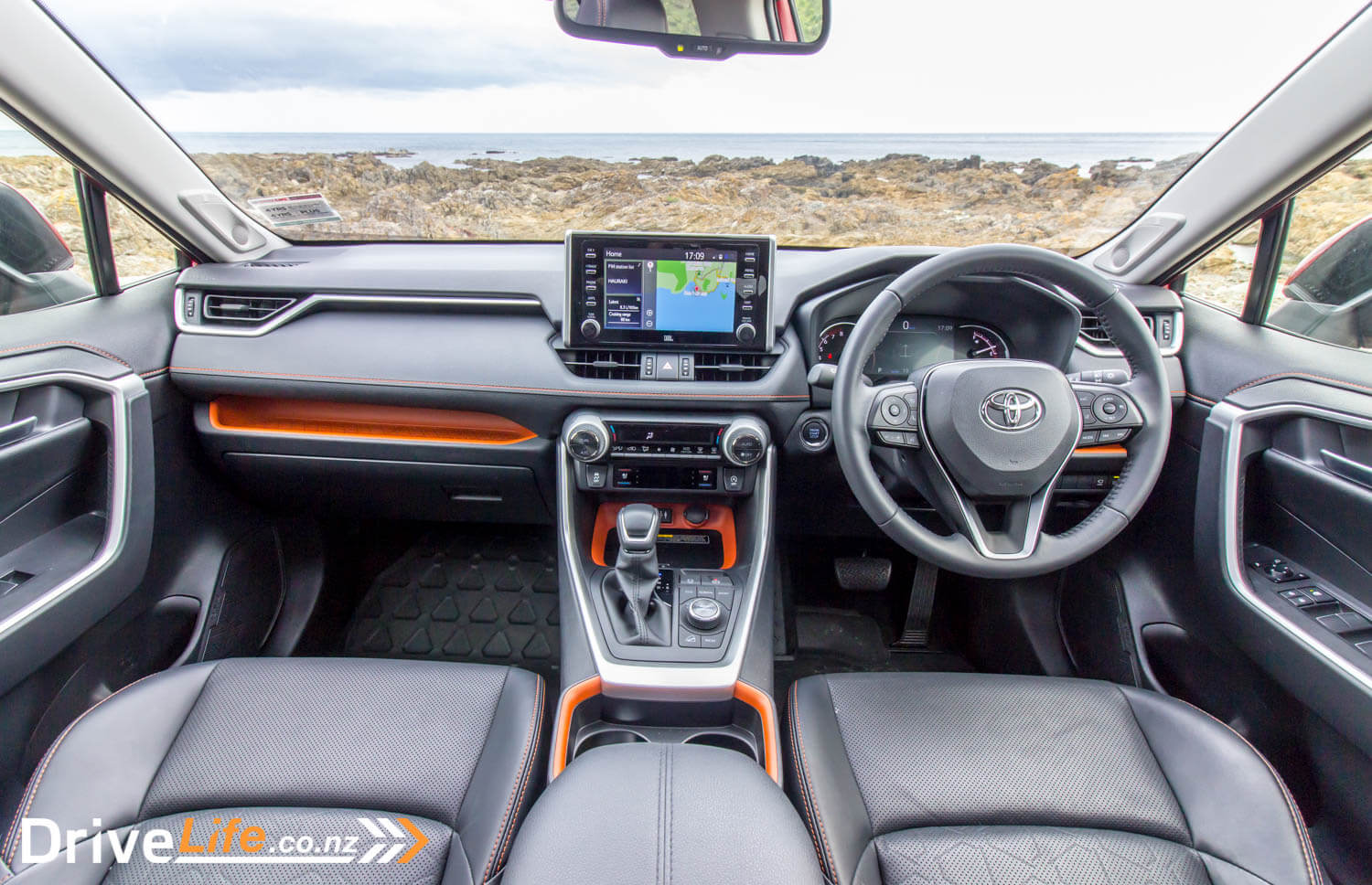
SatNav with SNUA traffic updates is also standard, as is an 8” touchscreen display, 7 airbags, an electric park brake, 6-speaker audio, all windows auto up/down, LED auto-levelling headlights, automatic headlights, fog lamps, LED DRLs, LED taillights, auto wipers, 17” alloy wheels, and an acoustic front windscreen.
If you go for the GXL model (hybrid or non-hybrid), that adds 18” alloys, dynamic guidelines for the reversing camera, keyless entry and start, a leather steering wheel, leather gearshift gaiter, climate dual-zone AC, an auto-dimming rear-view mirror, and privacy glass.
The Limited model adds yet more, so there’s now 19” alloys, a panoramic view monitor, a 9-speaker JBL audio system, leather seats, a 10-way power driver’s seat, heated front seats, a 7” colour driver’s display, extra interior illumination, and an electric tailgate.
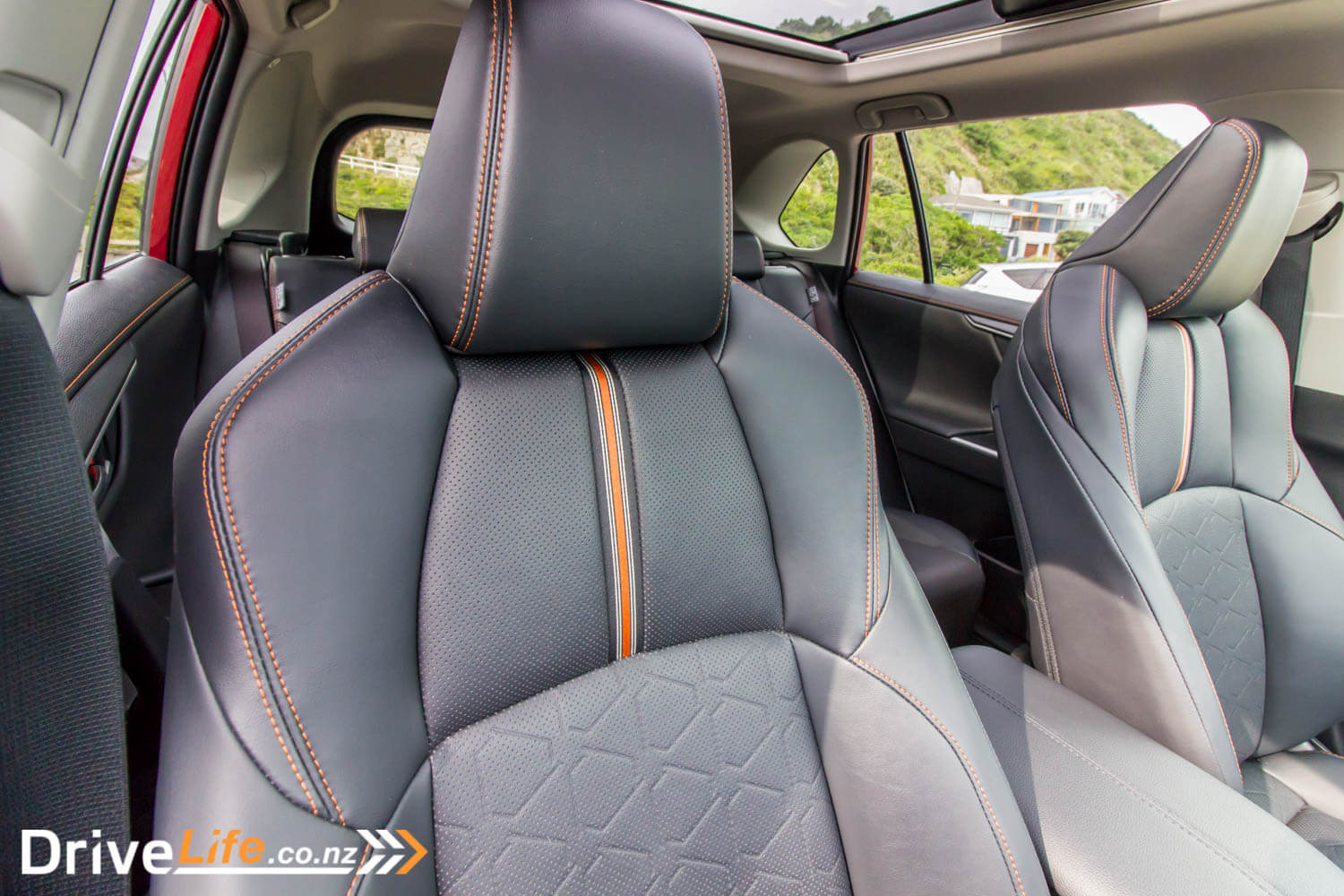
The Adventure model has heated and cooled front seats, and some added functionality around the AWD system, with extra drive modes like snow, mud, rock. The Adventure is noted for its, larger over-fenders, more aggressive bumper, grille design and fog light surrounds. Its 19-inch, five-spoke wheels with matte-black accents are exclusive to the Adventure model, as is a Safari Green colour option.
All RAV4s also include Trailer Sway Control which integrates braking of individual wheels and engine torque control to help quickly bring a swaying trailer back under control. While Trailer Sway Control is operating, the stop lights will automatically switch on to warn following vehicles to reduce speed.
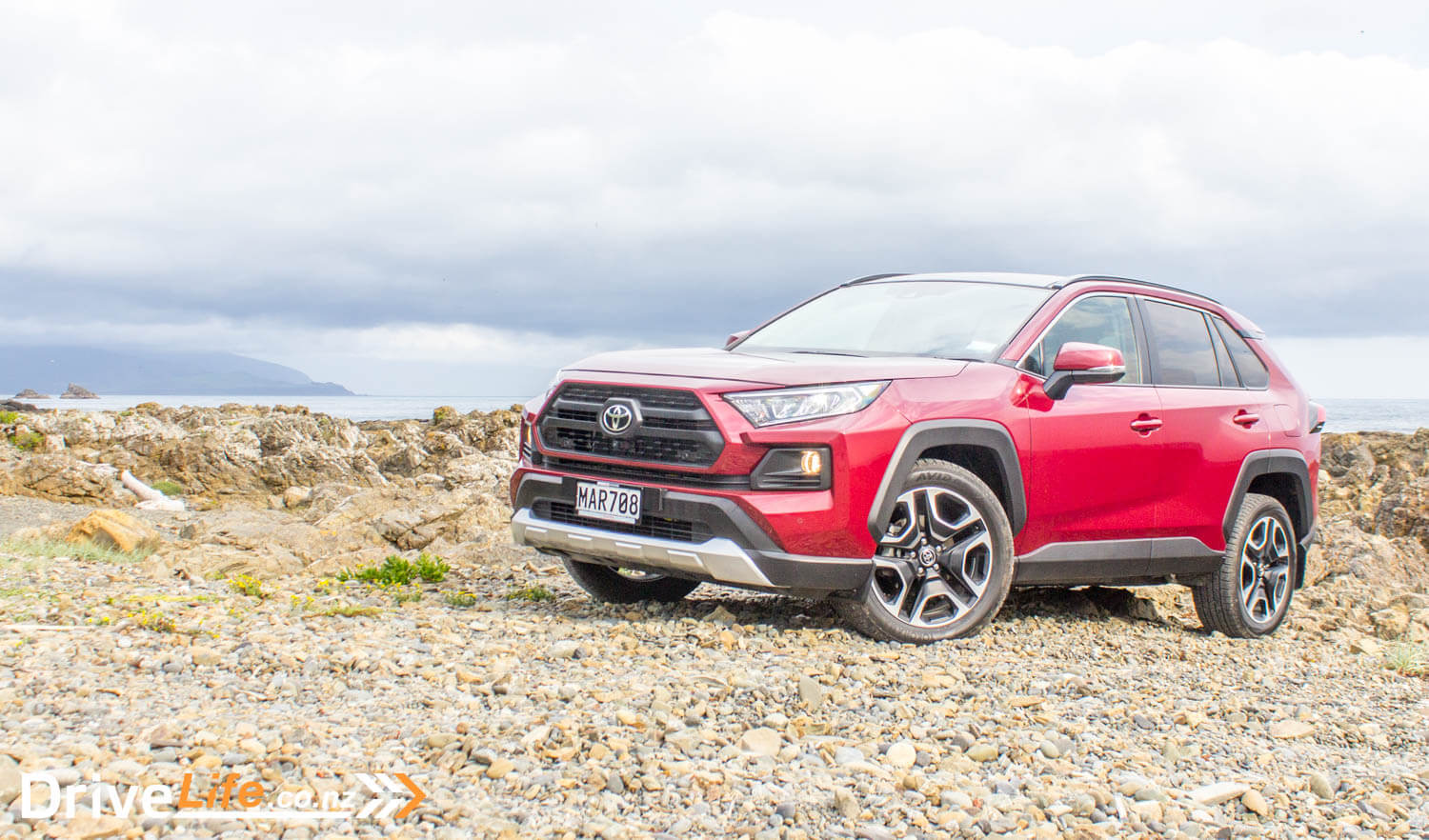
The RAV4 is available in nine exterior colours, including the three new colours, Safari Green (available only on the Adventure), Deep Sea Blue (available on GX, GXL and Limited) and Eclectic Blue.
2019 Toyota RAV4 Adventure- Pricing
- RAV4 GX 2.0 Petrol SUV FWD CVT $35,490
- RAV4 GXL 2.0 Petrol SUV FWD CVT $38,490
- RAV4 Limited 2.0 Petrol SUV FWD CVT $45,490
- RAV4 GXL 2.5 Petrol SUV AWD $42,490
- RAV4 Adventure 2.5 Petrol SUV AWD $49,990
- RAV4 GX 2.5 Hybrid SUV AWD ECVT $41,990
- RAV4 GXL 2.5 Hybrid SUV AWD ECVT $44,990
- RAV4 Limited 2.5 Hybrid SUV AWD ECVT $51,990
You can read more about the RAV4 on Toyota New Zealand’s website.

First Impressions Of The 2019 Toyota RAV4 Adventure
Unmistakably a RAV4, but refreshed and more modern. There’s not much to dislike about the design of the RAV4, especially in the Ruby Red that our test car came in.
It’s got that chunky big-truck look going up front, and Toyota has pulled it off. This can backfire on a car’s design, but on the RAV4 the proportions are just right. Toyota says the new gen RAV4 has a “more adventurous exterior”. I’m not sure about that, but I’m happy with the look.
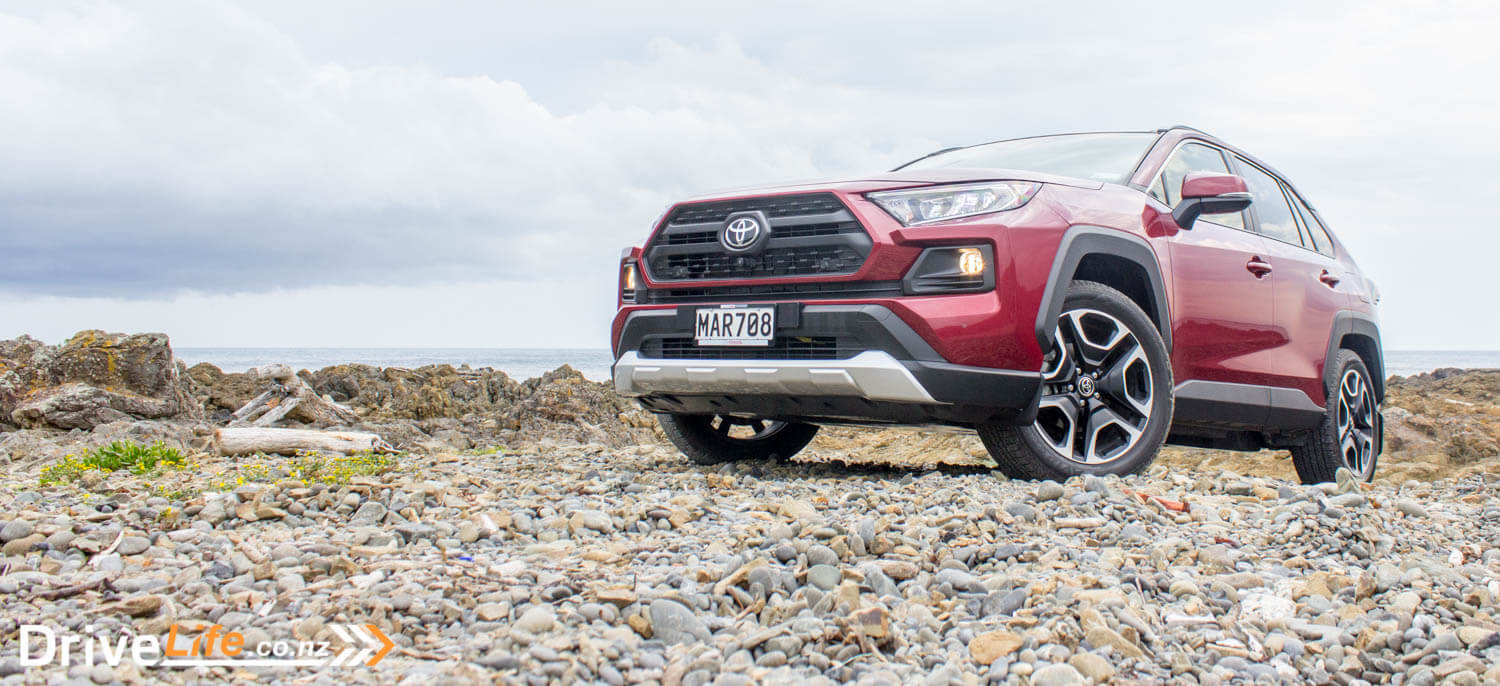
Side on, those huge plastic guards over the wheel arches catch your eye instantly. Interestingly, on the same day I had someone tell me they hated them, and then another person loved them. The car does look a little Subaru XV-ish side on, but I still like it. Those wheels look great, and are unique to the Adventure model.
Around the back, it’s still looking like a RAV4, with dual exhausts setting the rear off nicely.
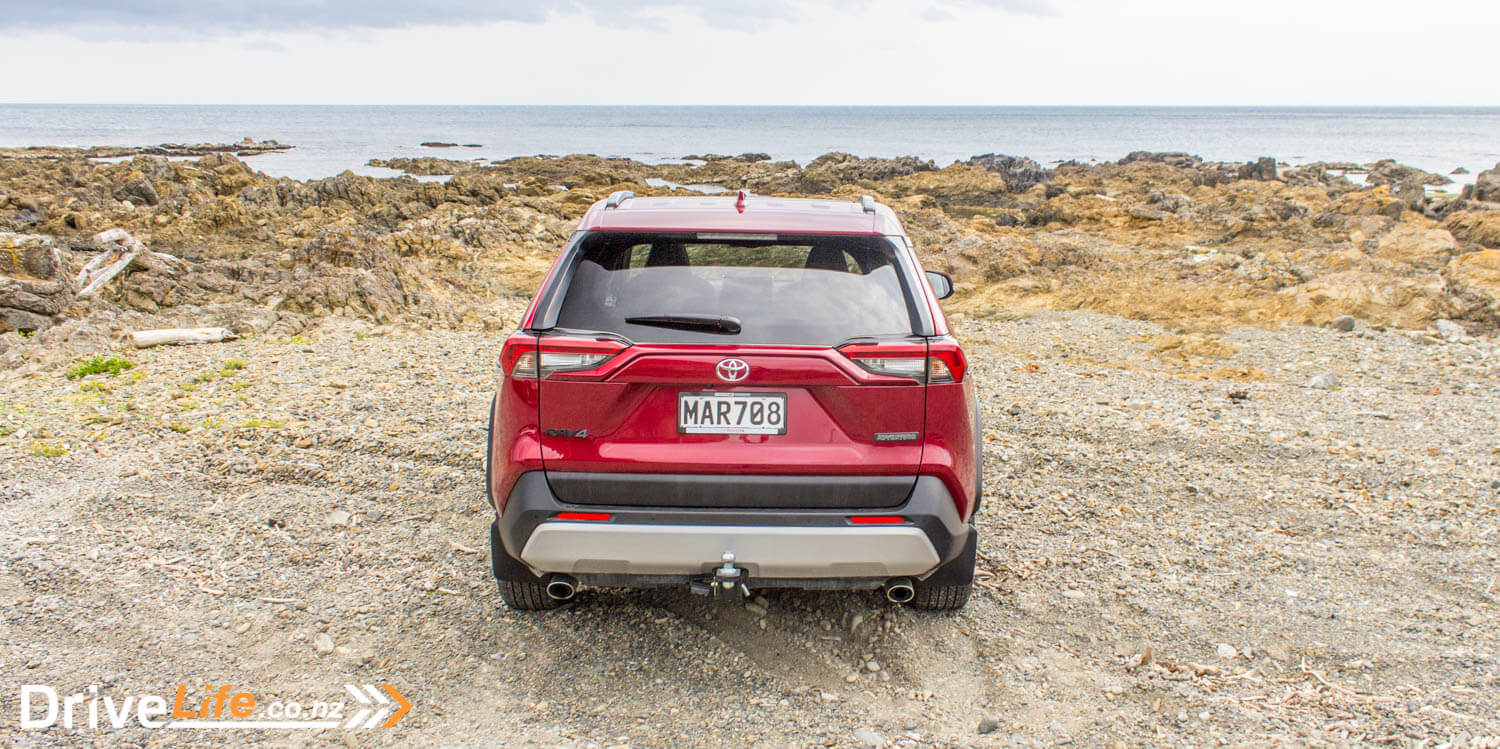
What’s The Inside Like On A 2019 Toyota RAV4 Adventure?
Orange is order of the day in the interior of the RAV4 Adventure. It grabs your eyes instantly; there’s orange stitching on the dash, doors and all seats. There’s orange drink holders, an orange cellphone shelf for the front seat passenger, an orange Qi wireless phone charger and the driver has an orange cubby to the right of the steering wheel. It’s not too garish though, and sure fits in with the projected funkiness of the RAV4. I liked it, some didn’t.
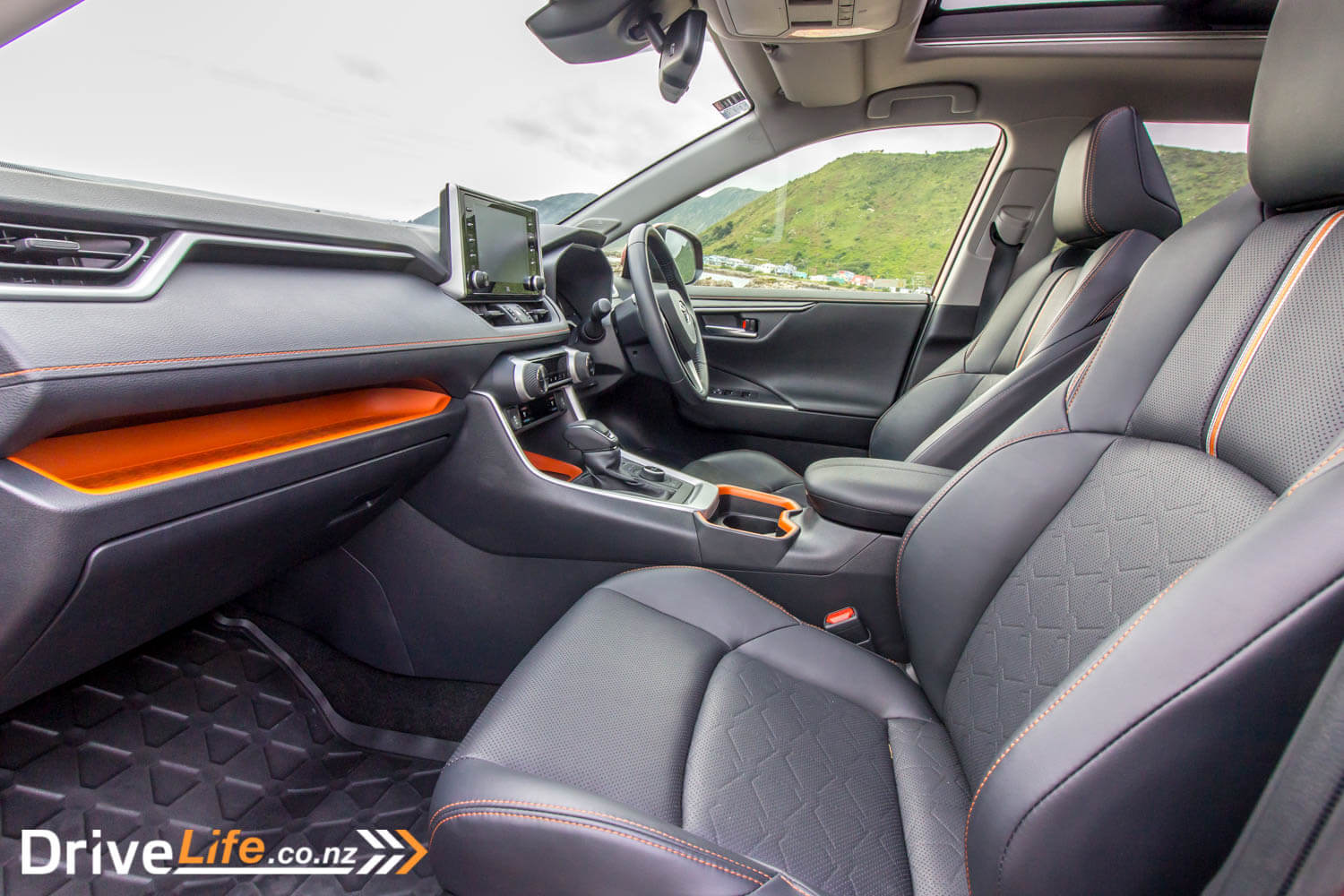
The seats are all black leather, but there’s the huge panoramic sunroof (with an electric blind) to keep it all light and airy inside. A beige headlining also helps in this department.
There’s quite a lot of hard plastics to be seen and felt, but this seemed to be in keeping with the RAV4’s image of at least being a little bit tough.
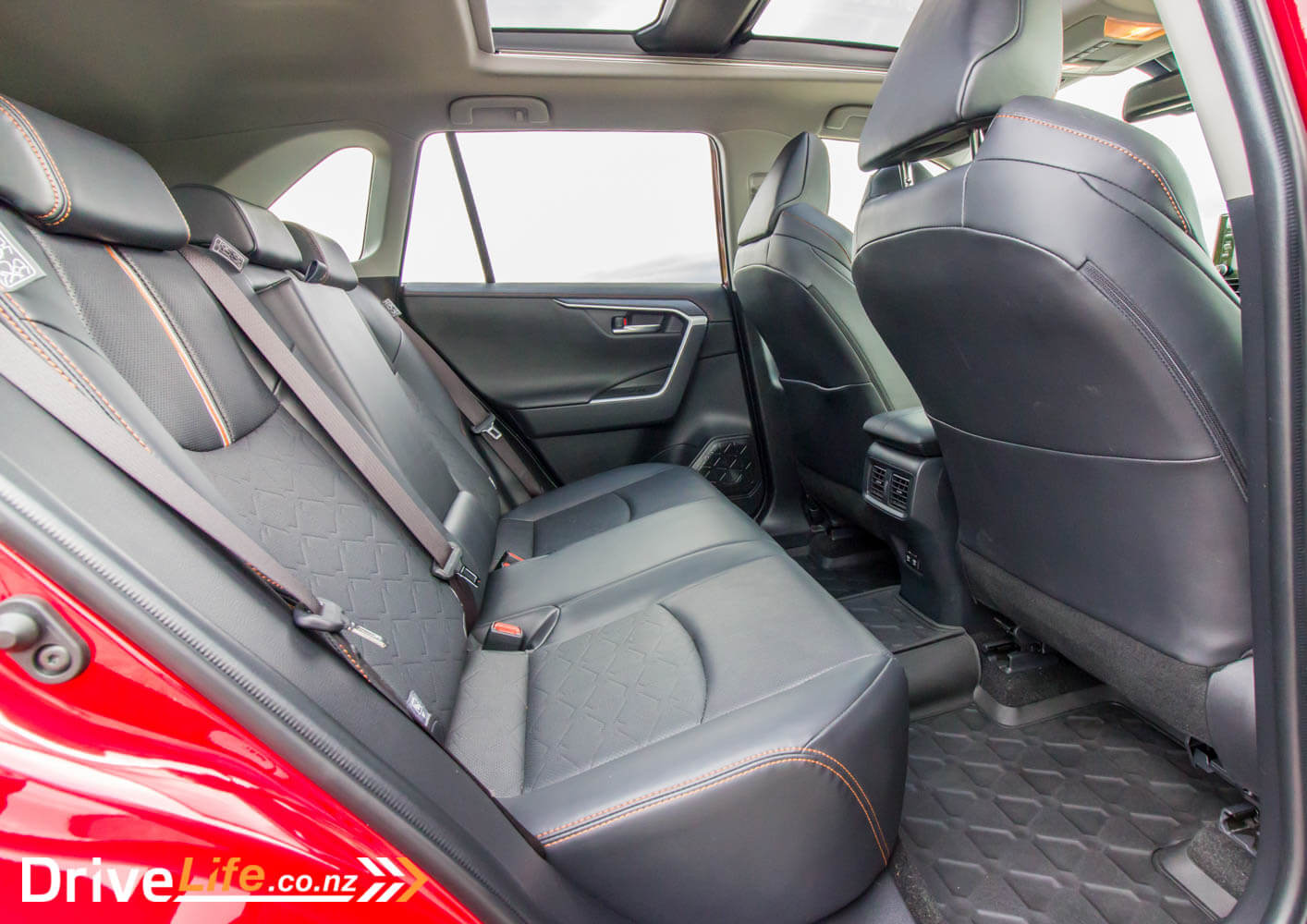
The new model has a higher road height and a longer wheelbase, which means more rear space and a larger opening rear door angle. The rear legroom is very good, and the cargo area at 542 litres is great for this size of SUV.
Under the floor you’ll find a space-saver spare wheel, and a small amount of storage space for other junk you carry around.
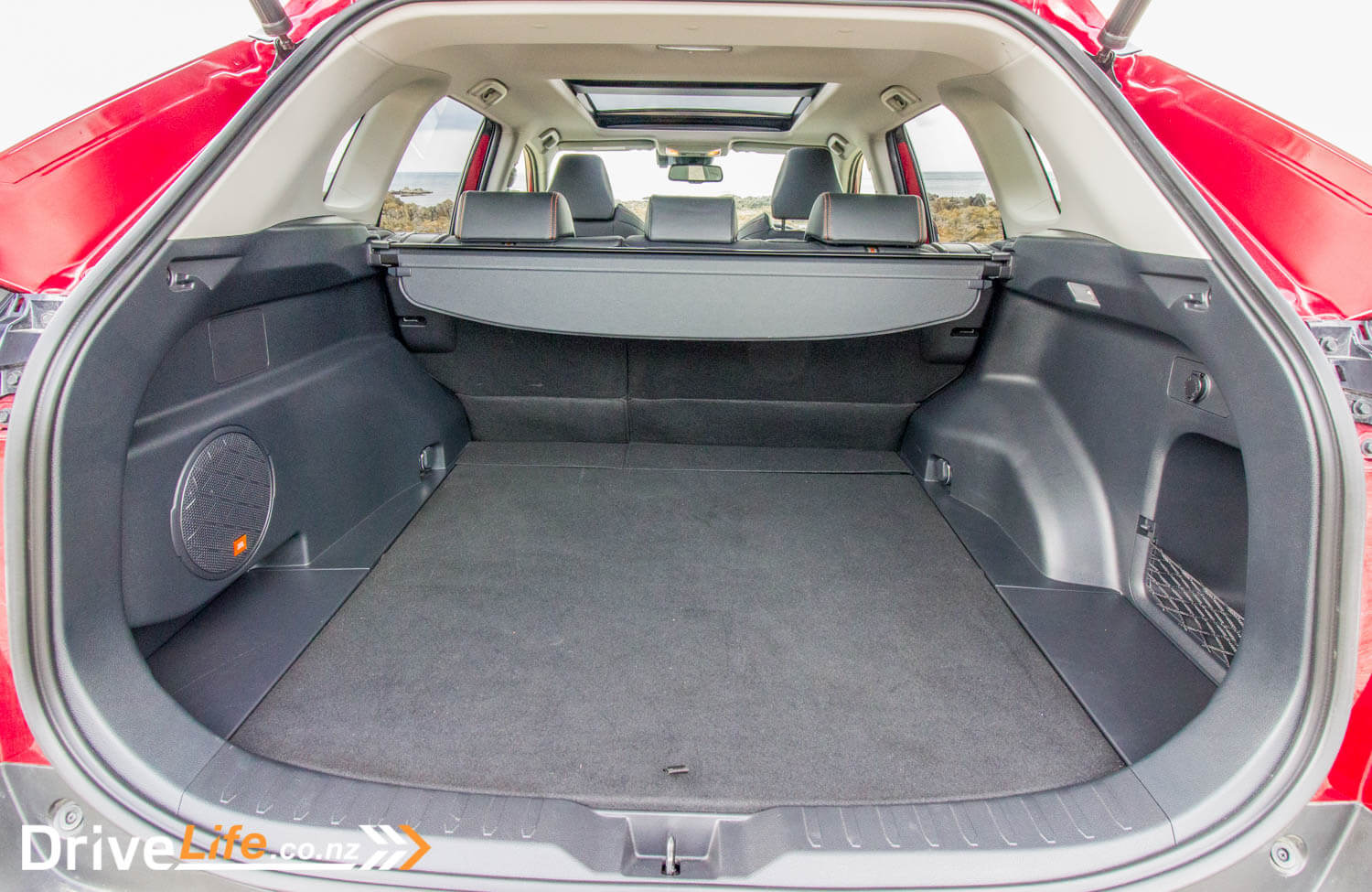
What Does The 2019 Toyota RAV4 Adventure Drive Like?
Instant thought? The engine is a little too noisy. At idle, inside the car, it makes itself known. Moving off, I still hear it, and this is an everlasting thought throughout the week. Hitting the motorway and sitting at a steady speed, it’s quiet and subdued, but hit any hills and that all-new ‘Dynamic Force’ 2.5-litre, 4-cylinder is not the quietest engine on the block. Even my wife, who is totally not a car person, mentioned how noisy it was.
I was happy initially that the Adventure model doesn’t have a CVT gearbox. I’m not a fan – they aren’t a gearbox for drivers in my view, but the Adventure has an 8-speed automatic transmission.
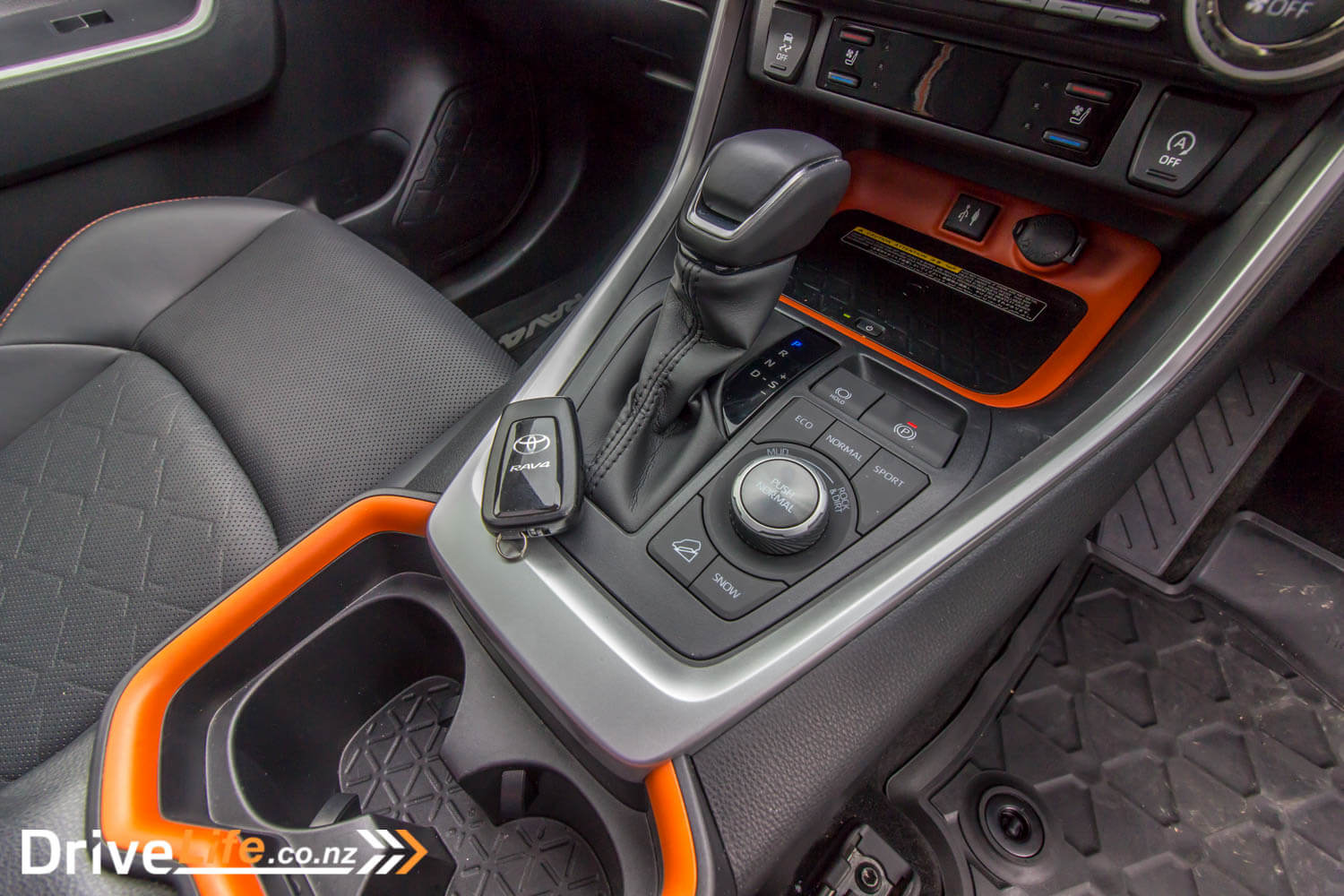
The problem is the jerkiness of the transmission. When you are moving, it’s not bad, but you can really feel it change gear, as the revs drop and it changes up. But this is a ‘normal’ gearbox with a torque convertor, not a dual-clutch (‘DSG’) gearbox, so it shouldn’t be like that. All changes should be smooth. But the worst part of the gearbox comes out at low speeds. Let’s say you get to a Give Way sign, so slow down almost to a crawl, then accelerate away again without stopping. There’s a pause as the gearbox decides what it’s going to do, and then almost a shunt, as it picks a gear and you accelerate away. I was really surprised by this behaviour, as this is common to DSG gearboxes, but not ‘torque converter’ automatic gearboxes like this model of RAV4 has.
Being the rough ‘n tough model, the Adventure does have some nice tools at hand if you want to do a little off-roading. There’s a 4WD mode for Mud/Sand, and Rock/Dirt, selectable using a knob. Then there’s buttons for Snow mode and Hill Descent Control. The rugged Adventure also features a Toyota first – Dynamic Torque Vectoring AWD – to help you in the rough stuff.
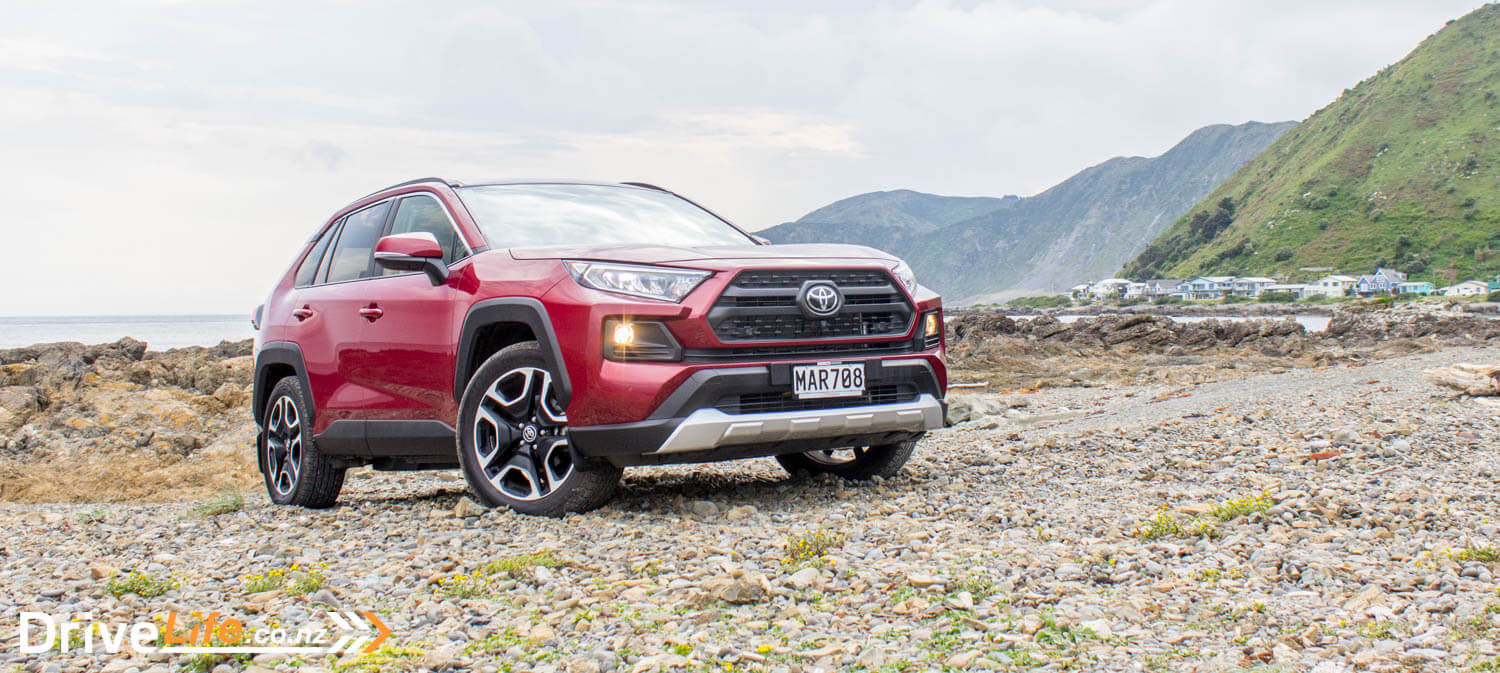
Of course, we all aren’t driving our RAV4s off-road all the time. I’m pretty sure most of the use will be around town, with the occasional trip to the ski fields. So what’s it like on the Daily Drive? Great to see adaptive cruise control as standard across all models, and here’s hoping we see more of this in other brands and models. Thankfully too, cruise control is operated from the steering wheel, and not Toyota’s default position, a stalk. Everyone I know prefers steering wheel controls. It’s all very simple to use from the wheel, and good to see that when using traffic sign recognition, if your speed limit changes, you can hold the speed-up or speed-down button (depending on the change) and cruise control will automatically switch to the new speed limit. Excellent stuff.
Another bonus for cruise control is that it will bring you to a full stop, and then start off again with a touch of the gas pedal or a touch of the set/resume button on the steering wheel. There’s still some new cars out there that don’t do this.
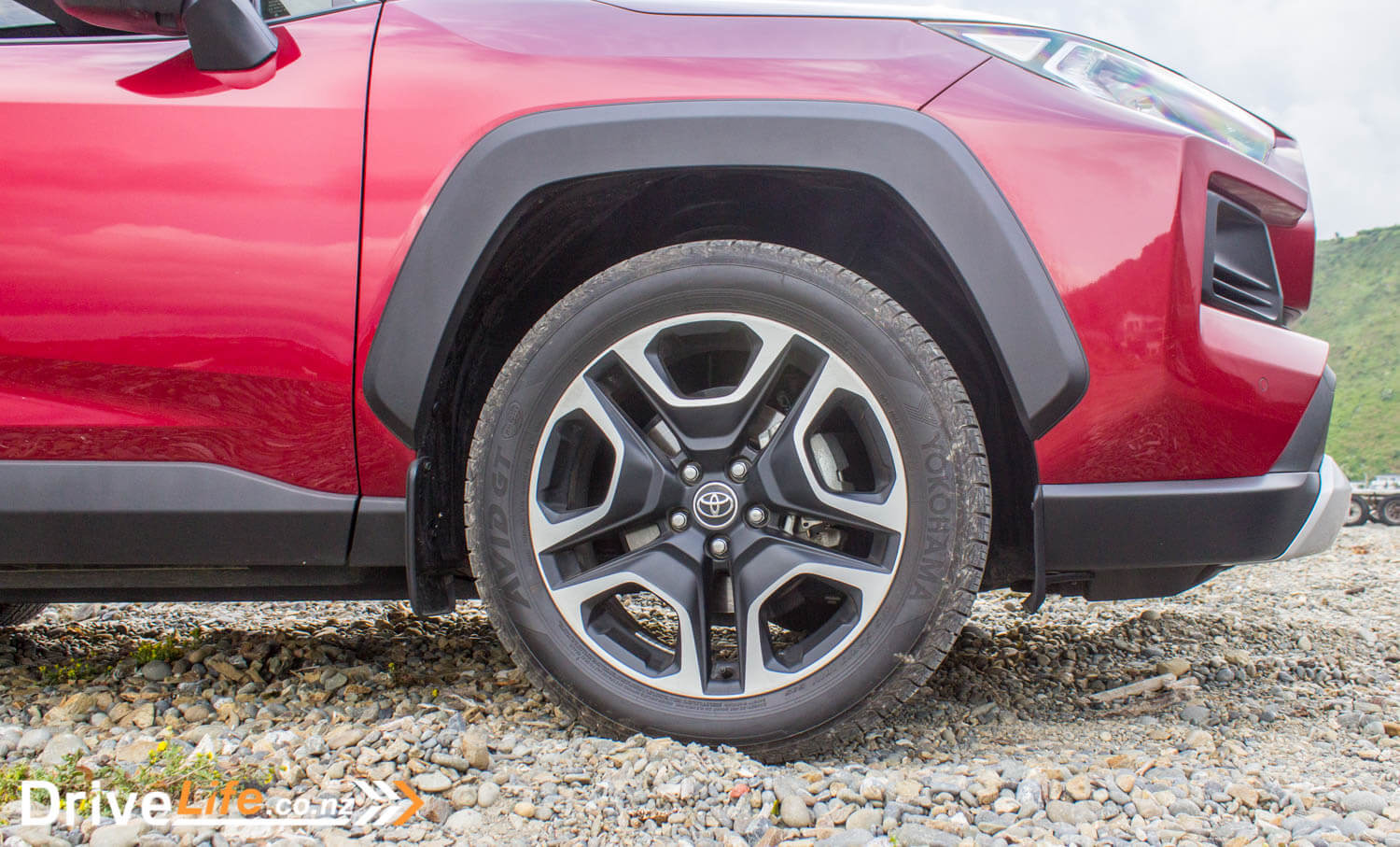
Not so great on the cruise control front is downhill speed. Incredibly, when using adaptive cruise control the RAV4 doesn’t brake down a hill, unless there’s a car in front of you. In the manual, it simply says, “Vehicle speed may exceed the set speed when driving down a hill.” It sure does. This can cause a few issues; simplest of all, you could get a speeding ticket. If there is a car in front of you, the RAV4 will slow down of course, but if there’s no cars, you have to be very careful. I can only remember one other car that did this, the Nissan Pathfinder. Please Toyota, sort it out.
There are some great things about the RAV4 for the Daily Drive. With big side windows, big exterior mirrors and blind-spot monitoring, visibility and safety are excellent. The chassis is excellent too – the ride is spot on, steering feel is very good and if you want to push the car around some twisty corners, it will do just fine. The steering wheel feels nice too – it’s leather of course, and just the right size for the car. I’ve got mixed feelings on the steering wheel controls. As mentioned, the cruise control ones do fine, but like some other cars we’ve had lately, Toyota have split the audio controls left and right. So on the left you have volume, and on the right is track/station forward/reverse. I’m sure I’d get used to I eventually, but I kept finding that I wanted to change the volume, and my fingers would go to the right, and ditto for changing a track, but to the left side. A little frustrating, but I’m sure over time it would become second nature.
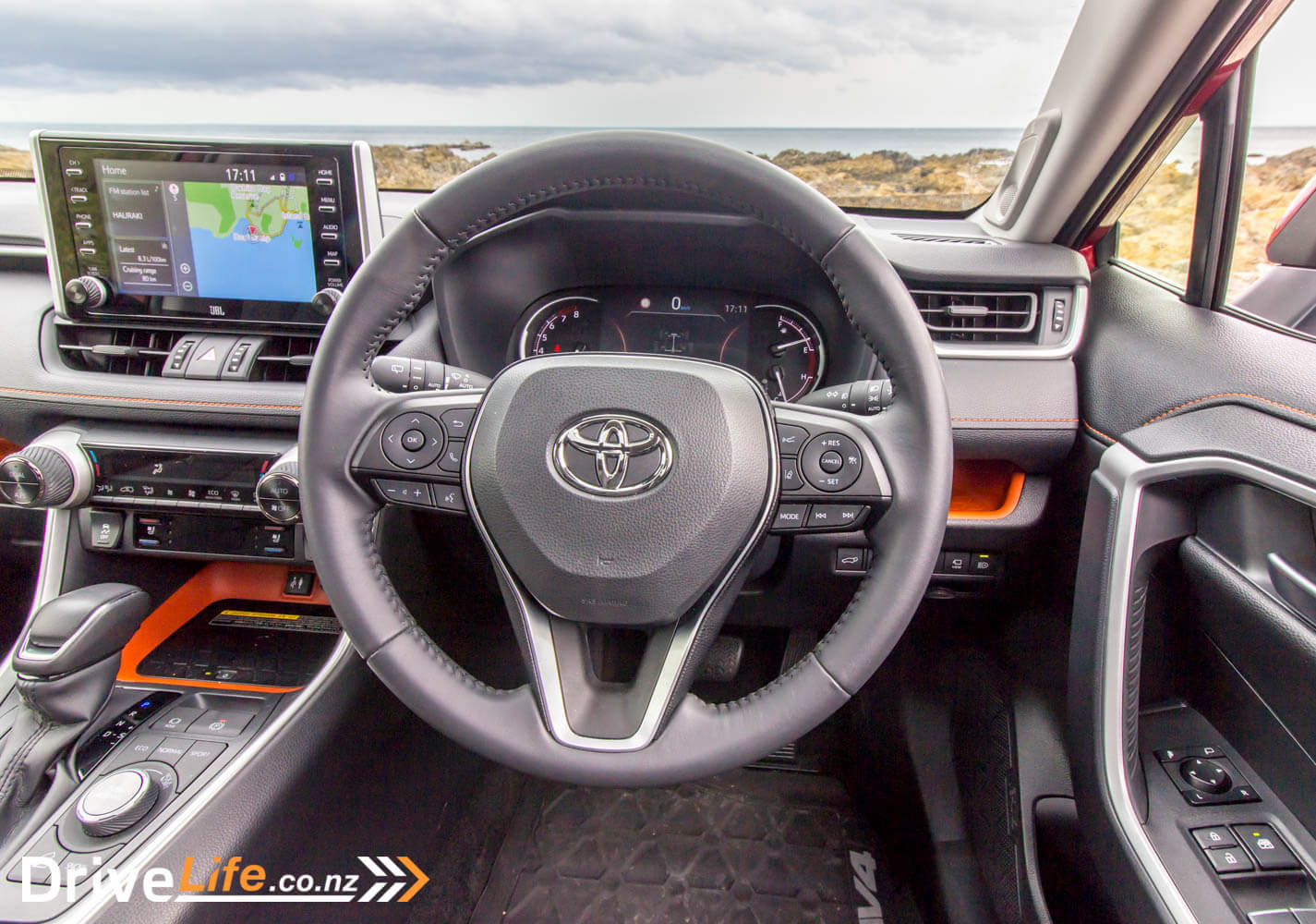
With the panoramic sunroof, you’d think that would make a heck of a racket with it open on the motorway. But there’s a nicely-sized pop-up wind deflector up there, and it does a great job of reducing wind buffeting and noise with the sunroof open.
Brakes are up to the mark as well, nicely progressive and with excellent feeling – they inspire confidence when you need to brake hard.
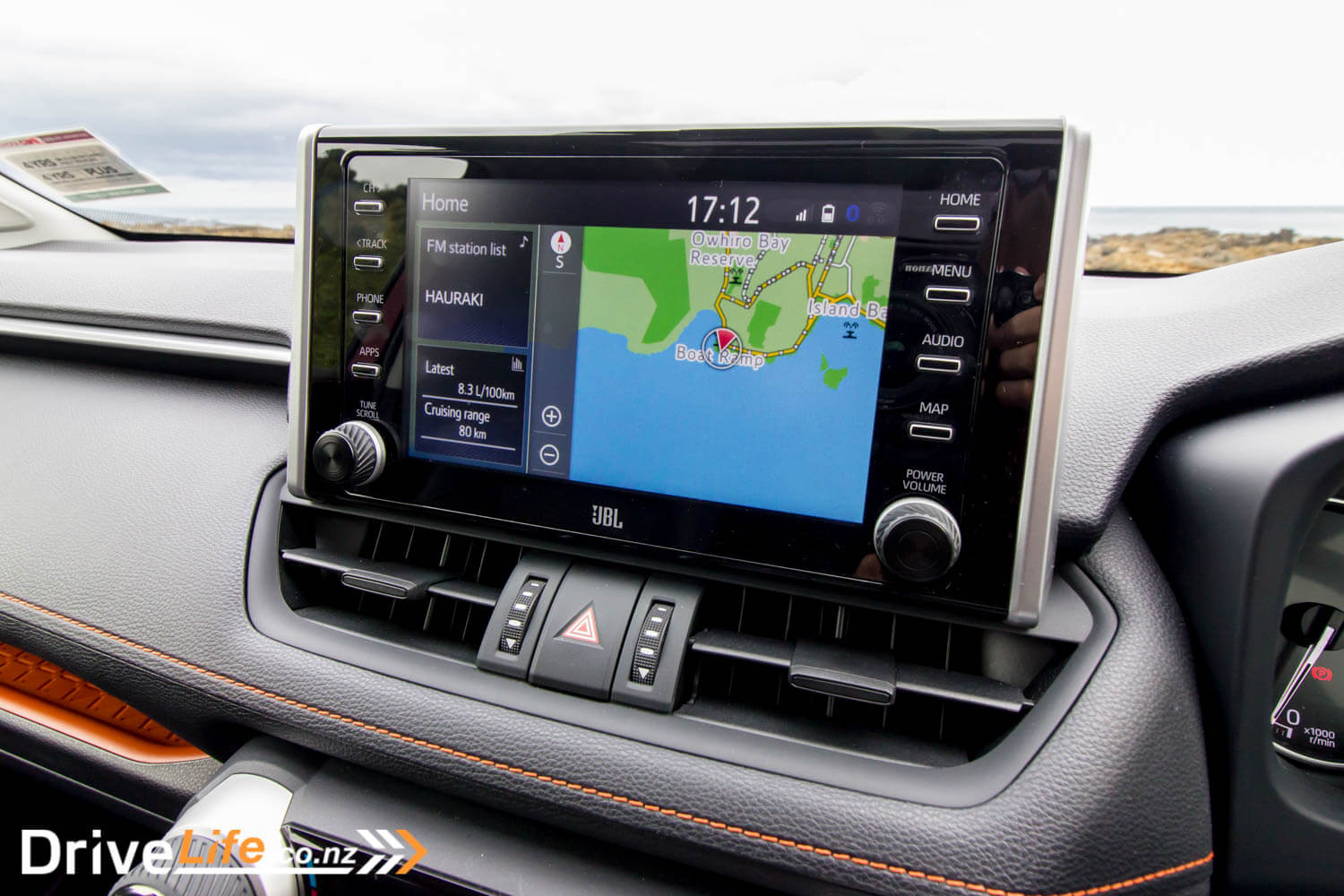
On the motorway commute, things are pretty good overall. SatNav with SUNA traffic updates is standard across all models, so good on Toyota for adding this. The central display makes good use for SatNav, with a split-screen when the map is up – you get an overview of your journey on the left side, and then the right is used to zoom into roundabouts, or motorway lane changes. It’s perfectly done, and of course you get turn by turn directions in the Driver’s Information Display (DID) as well.
But now we’ve broached another touchy subject – the touchscreen central display. The resolution is very low compared to others in this segment, and Toyota’s menu system feels clunky, and out of date. It’s well overdue for a change here. It’s not bad, but it’s been left behind by others. On that note, the Adventure model has a 360-degree camera, which is good news – there aren’t many who don’t love this feature. But again, the resolution is pretty low. You can still make objects out, but it pales into comparison of other systems. On the plus side, there is an ‘auto’ feature, so the 360-degree camera comes automatically on at low speeds, and that I love.
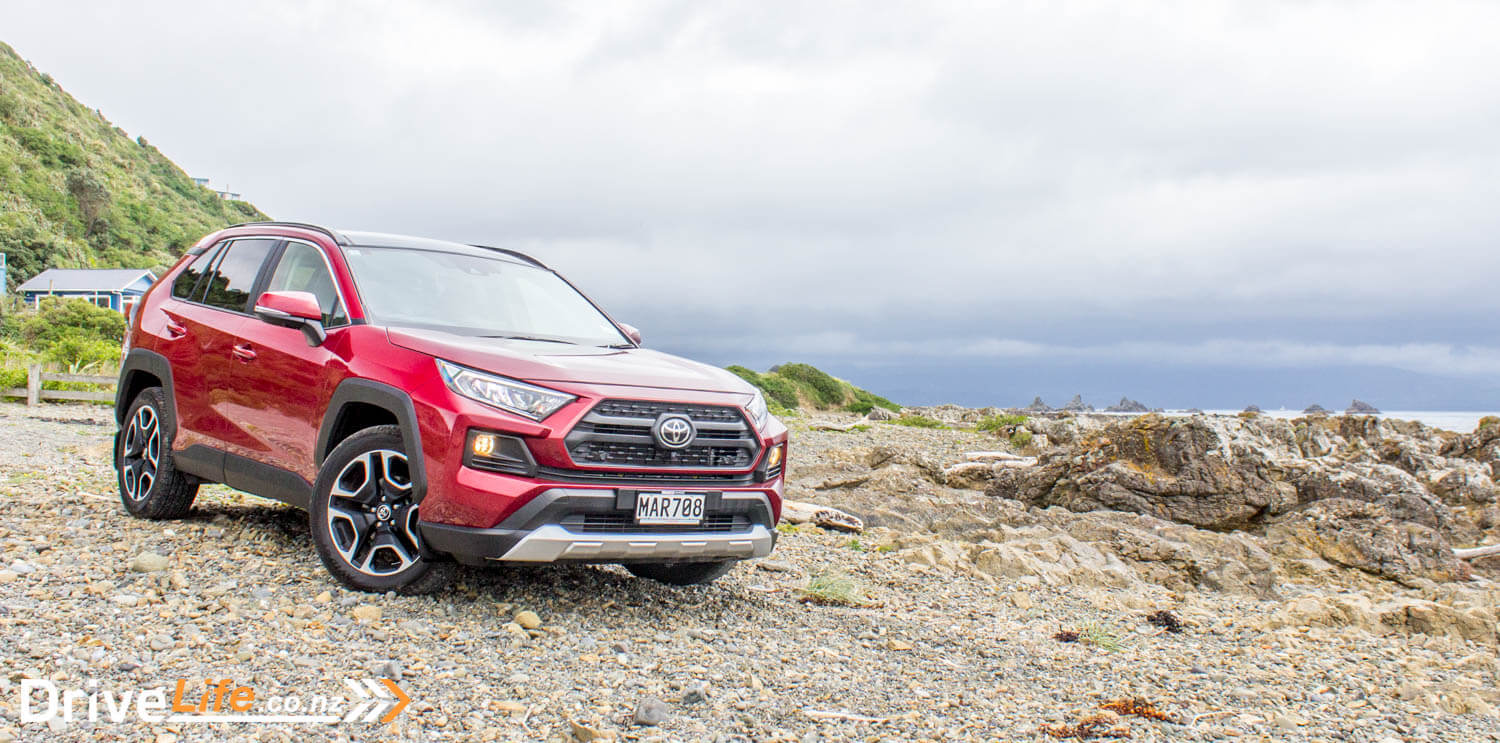
Still on the plus side for the touchscreen, is the Home page. At least it has one, and it’s always useful, instead of simply having only media, or the map showing. With the RAV4, you can customise the screen so you can pick what’s on the top left, bottom left, and the rest of the screen on the right. This is excellent, and I hope Toyota doesn’t change it. The display itself is sticking with the tacked-on look, which is a shame, as other manufacturers make an effort to integrate their displays into the dashboard.
The RAV4 has brake auto-hold, and as I’ve said many times, I love this feature. It makes driving a lot safer – if you remember to turn it on. I’m not sure why, but many manufacturers have brake auto-hold go off with the ignition. Euro cars do it right – auto-hold comes back on when you start the car again. It can be dangerous if it doesn’t, as I found out; we were getting some drive-through coffees, and I had forgotten we had stopped the car previously – so auto-hold was off. We ordered coffee, I let my foot off the brake, knowing that auto-hold would keep me there. But it wasn’t on. Luckily, forward emergency braking stopped me touching the car in front – phew! – but I wish this could be optioned in the menus, so it always came back on with the car, if you had it on when you got out. I live in hope. It was a good test of forward emergency braking, at least.
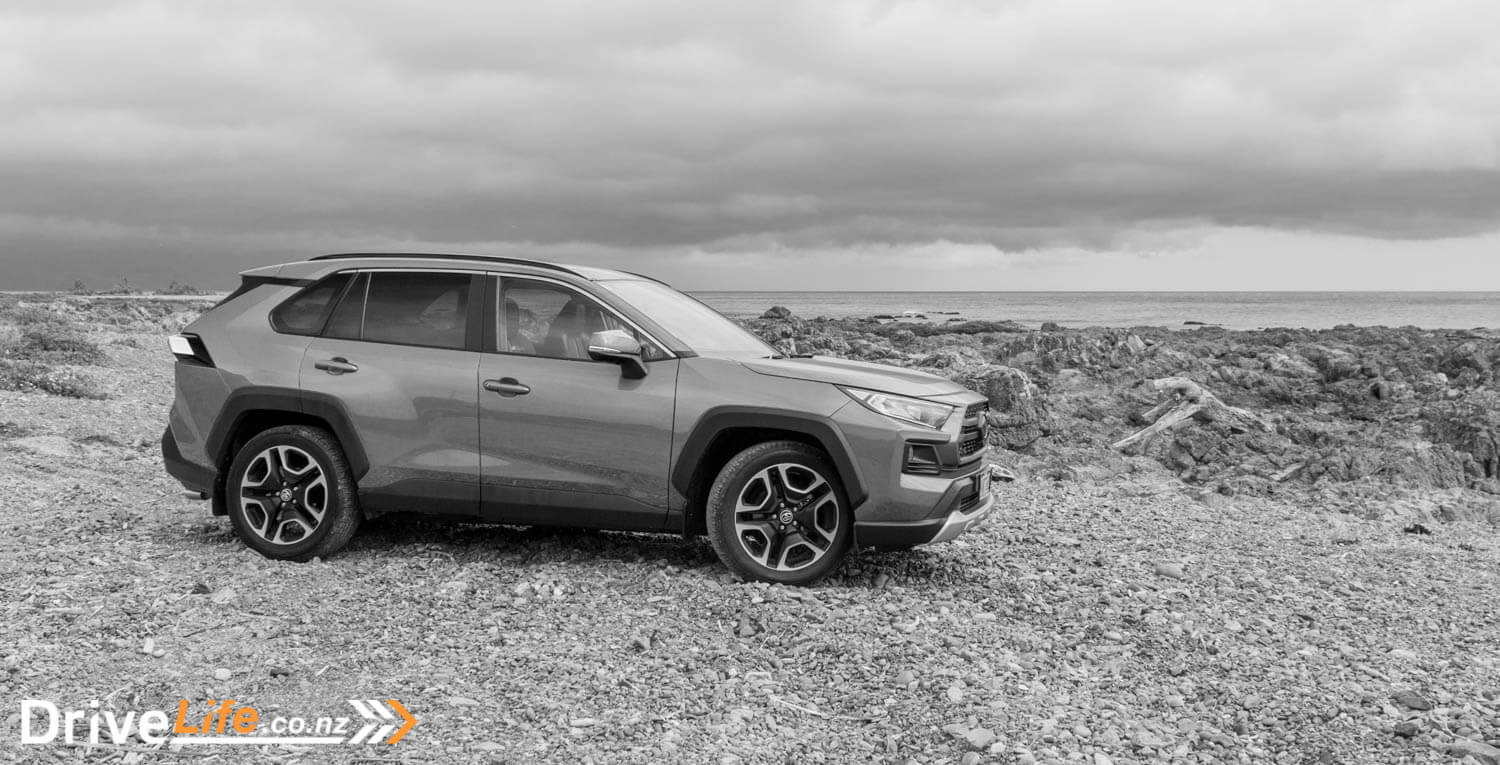
Still on the Daily Drive, all windows are auto up/down, so that’s a bonus. The cubby at the rear of the centre console is a good size, easily fitting in an SLR camera with room to spare. There are 2 USB ports in there too, as well as another 2 up front, along with a 12-volt power socket.
I made the most of the heated and cooled front seats, and I see it’s only the Adventure model that gets these. A bonus here is that the RAV4 remembers the setting you had when you got out of the car. A small touch, but brilliant. In fact, the Adventure model is pretty well equipped, for the price. I think the only thing missing was a heads-up display, so I had to make do with the gauges. On that front, there’s no speedo dial in the RAV4 – you only get a digital speedo in the top part of the DID. That doesn’t worry me on the whole, but the digital speedo is too small; these days, when apparently only your speed matters for road safety, the digital speedo needs to be twice the size it is.
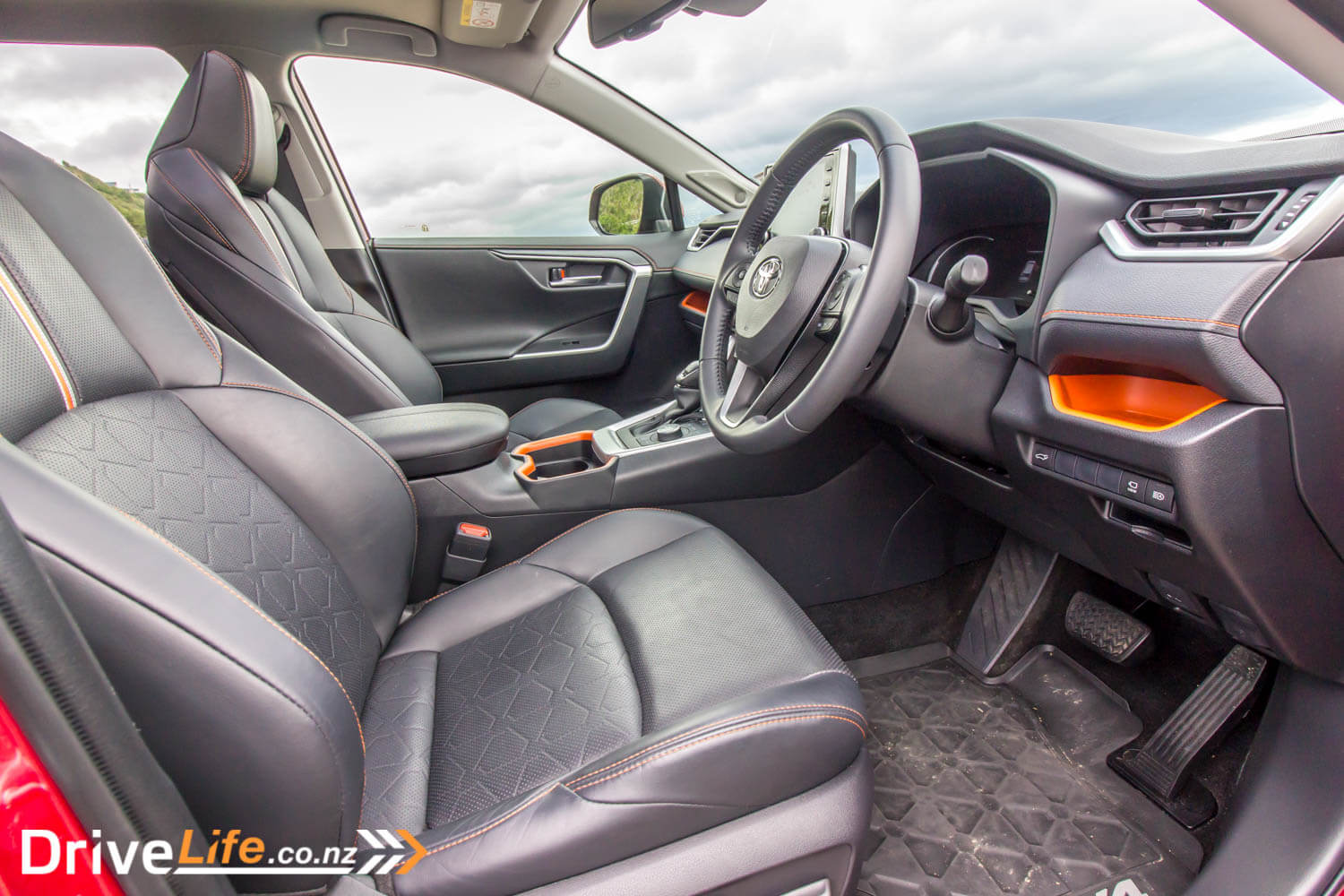
The DID itself is huge, and takes up massive real-estate in front of the driver’s eyes. You can pick from the usual info there, and I generally left it on the drivetrain page, so I could see where the drive was going. I don’t normally worry about this too much, but in the Adventure model you can see not only front/rear drive, but left and right. It was cool that as you went around say a left-hand bend, drive on the left-rear wheel would drop to nothing, but increase on the right-rear, because that’s where the grip is.
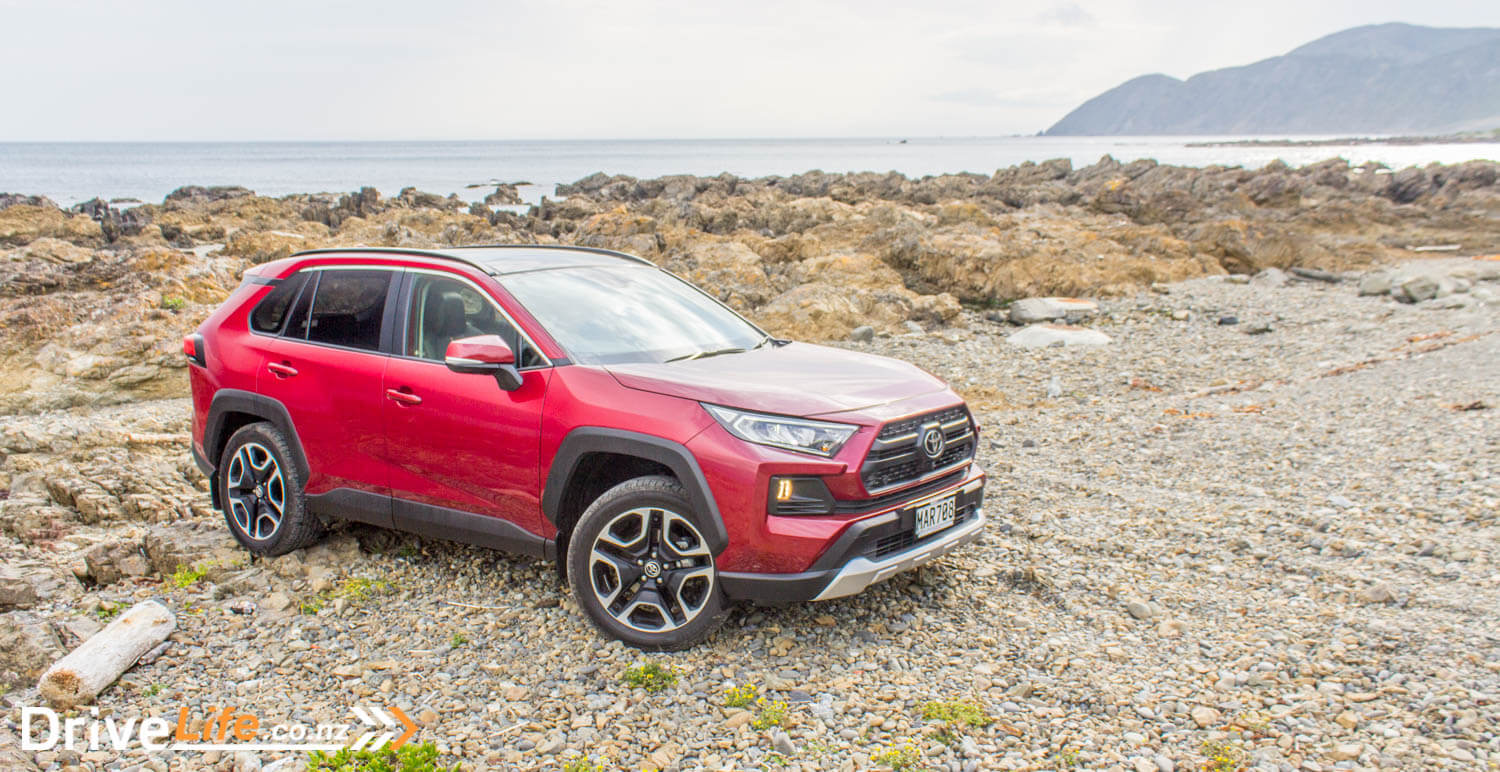
I mentioned the 2.5-litre motor is a fair bit noisy, but what about performance? It’s just okay. I was expecting more from a 2.5-litre 4-cylinder, it doesn’t really get up and go like you’d expect it to. Maximum torque comes in between 4000 and 5000rpm, so you really have to wind this engine out to get it to perform. And due to the noise, it doesn’t feel right to do that. Apparently in the back seat, the engine actually sounds quite nice, but up in front, it’s a different story. Even in Sport mode, it never feels punchy, and that’s a shame. One day we were driving up Wainui Hill, and I had my foot flat down, waiting for acceleration. It never came. Sure, it’s a steep hill, and I could have pushed the accelerator down more quickly to make it change down a gear or two, but a 2.5-litre motor should be able to grunt up hills without doing that. It gets from rest to 100km/h in 8.5 seconds, which is reasonable.
In a win for the engine is fuel economy. I averaged 8.2L/100Km in my week and almost 500km of mixed driving. That’s pretty darn good for a 2.5, and is very good compared to the 9.6 I got from the 2.5-litre Subaru Outback (another slowish 2.5-litre car). Toyota suggests the combined rating should be 6.8L/100Km.
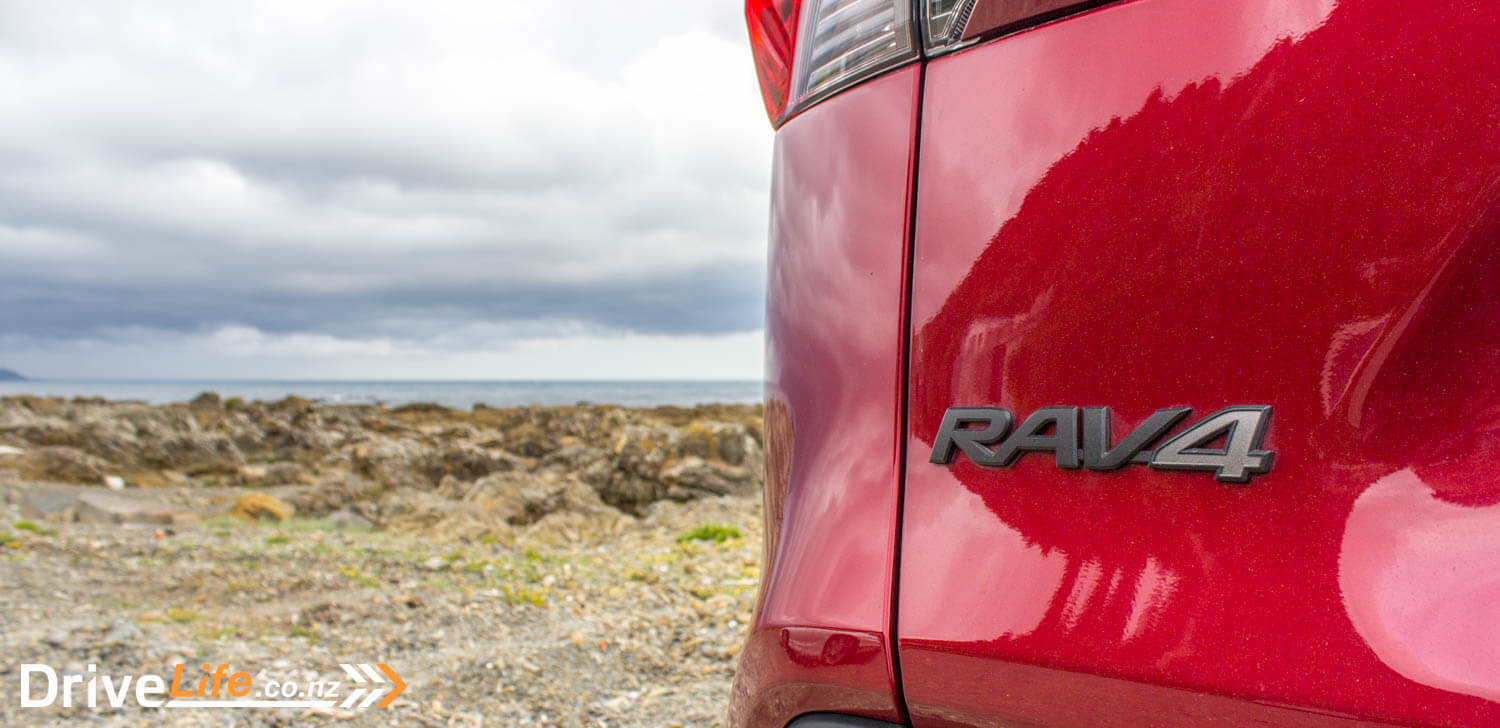
What’s The Competition For The 2019 Toyota RAV4 Adventure?
Competition, anyone? There’s a lot of players in this segment…
| Brand/Model | Engine | Power/ Torque kW/Nm | Seats | Cargo capacity, litres | Towing capacity, unbraked/braked | Fuel L/100km | Price |
| Hyundai Tucson Limited AWD | 2.0-litre, 4-cylinder turbo | 130/265 | 5 | 488 | 750/1600 | 7.7 | $59,990 |
| Renault Koleos Sport AWD | 2.5-litre, 4-cylinder | 126/226 | 5 | 458 | 750/2000 | 8.3 | $56,990 |
| Mazda CX-5 Limited AWD | 2.5-litre, 4-cylinder | 140/252 | 5 | 455 | 750/2000 | 7.4 | $55,995 |
| Holden Equinox LTZ AWD | 2.0-litre, 4-cylinder turbo | 188/353 | 5 | 846 | 750/2000 | 8.2 | $52,990 |
| Skoda Karoq TSI Sportline AWD | 2.0-litre, 4-cylinder turbo | 140/320 | 5 | 521 | NA/1500 | 7.6 | $52,990 |
| Kia Sportage GT Line AWD | 2.4-litre, 4-cylinder | 135/237 | 5 | 466 | 750/1500 | 8.5 | $51,990 |
| Peugeot 3008 GT Line FWD | 1.6-litre, 4-cylinder turbo | 121/240 | 5 | 591 | NA | 7.3 | $51,990 |
| Toyota RAV4 Adventure AWD | 2.5-litre, 4-cylinder | 152/243 | 5 | 542 | 750/1500 | 6.8 | $49,990 |
| Ford Escape ST-Line AWD | 2.0-litre, 4-cylinder turbo | 178/345 | 5 | 406 | 750/1500 | 8.6 | $49,495 |
| Honda CR-V Sport Sensing AWD | 1.5-litre, 4-cylinder turbo | 140/240 | 5 | 522 | NA | 7.4 | $48,990 |
| Volkswagen Tiguan Allspace TSI Comforline AWD | 1.4-litre, 4-cylinder turbo | 110/250 | 7 | 615 | NA | 7.0 | $47,990 |
| Mitsubishi Eclipse Cross VRX AWD | 1.5-litre, 4-cylinder turbo | 112/254 | 5 | 374 | 750/2000 | 7.7 | $47,590 |
| Subaru Forester Premium AWD | 2.5-litre, 4-cylinder | 136/239 | 5 | 498 | 1500 | 7.4 | $47,490 |
| Nissan X-Trail ST-L AWD | 2.5-litre, 4-cylinder | 126/226 | 5 | 565 | NA | 8.3 | $47,490 |
| Foton Sauvana AWD | 2.8-litre, 4-cylinder turbo-diesel | 130/365 | 7 | NA | NA | 8.9 | $43,990 |
| Suzuki Grand Vitara SE AWD | 2.4-litre, 4-cylinder | 122/225 | 5 | 375 | 600/1200 | 9.9 | $38,990 |
| MG ZS Essence X FWD | 2.0-litre, 4-cylinder turbo | 162/350 | 5 | 359 | 500/NA | 9.6 | $37,990 |
| Mahindra XUV500 AWD | 2.2-litre, 4-cylinder turbo | 103/320 | 7 | NA | NA | 11.0 | $36,500 |
What’s The Pros and Cons For The 2019 Toyota RAV4 Adventure?
| Pros | Cons |
| Brakes Ride quality Fuel economy Cargo space Rear legroom Lots of features Safety features Design Airy interior | Low res central display Gearbox can be jerky Engine noise Performance Cruise control doesn’t brake downhill |
What’s The Verdict On The 2019 Toyota RAV4 Adventure?
I didn’t really like the 2.5-litre RAV4 Adventure. It’s got some great points, and it’s beautifully put together, but the engine noise, lack of performance and jerkiness of the transmission put me right off.
It is reasonable value, and Toyota has filled it with usable features.
Previously to this generation car, I would have said, “but people will buy it anyway”. But now, they don’t have to; forget this model – unless you really want the Adventure pack – and go straight to the hybrid version. Smoother, quieter, quicker, and only a couple of grand more. It’s a no-brainer.

2019 Toyota RAV4 Adventure – Specifications
3.5 Chevrons
| Vehicle Type | 5 door, medium-sized, all-wheel-drive SUV |
| Starting Price | $49,990 |
| Price as Tested | $49,990 |
| Engine | 2.5-litre, 4-cylinder petrol |
| Transmission | 8-speed automatic |
| Power, Torque kW/Nm | 152/243 |
| Spare Wheel | Space saver |
| Kerb Weight, Kg | 1,595 |
| Length x Width x Height, mm | 4610x1865x1690 |
| Cargo Capacity, litres | 542 |
| Fuel Economy, L/100km | Advertised Spec – combined – 6.8 Real-World Test – combined – 8.2 Low Usage: 0-6 / Medium Usage 6-12 / High Usage 12+ |
| Fuel tank capacity, litres | 55 |
| Towing Capacity Kg, unbraked/braked | 780/1500 |
| Turning circle, metres | 12.2 Small: 6-10m / Medium 10-12m / Large 12m+ |
| Warranty | 3 years, 100,000km |
| ANCAP Safety Ratings | 5 Star |
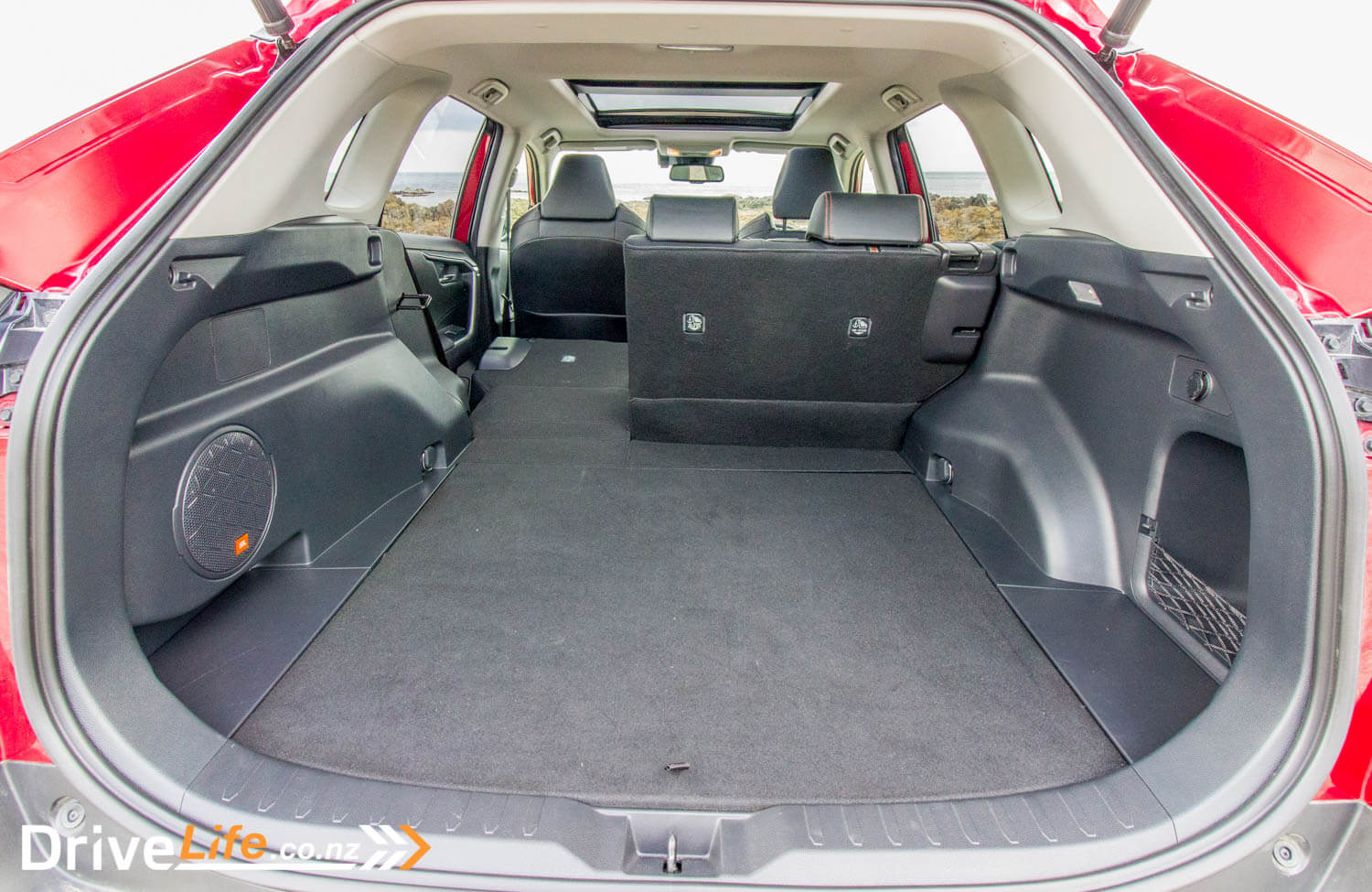
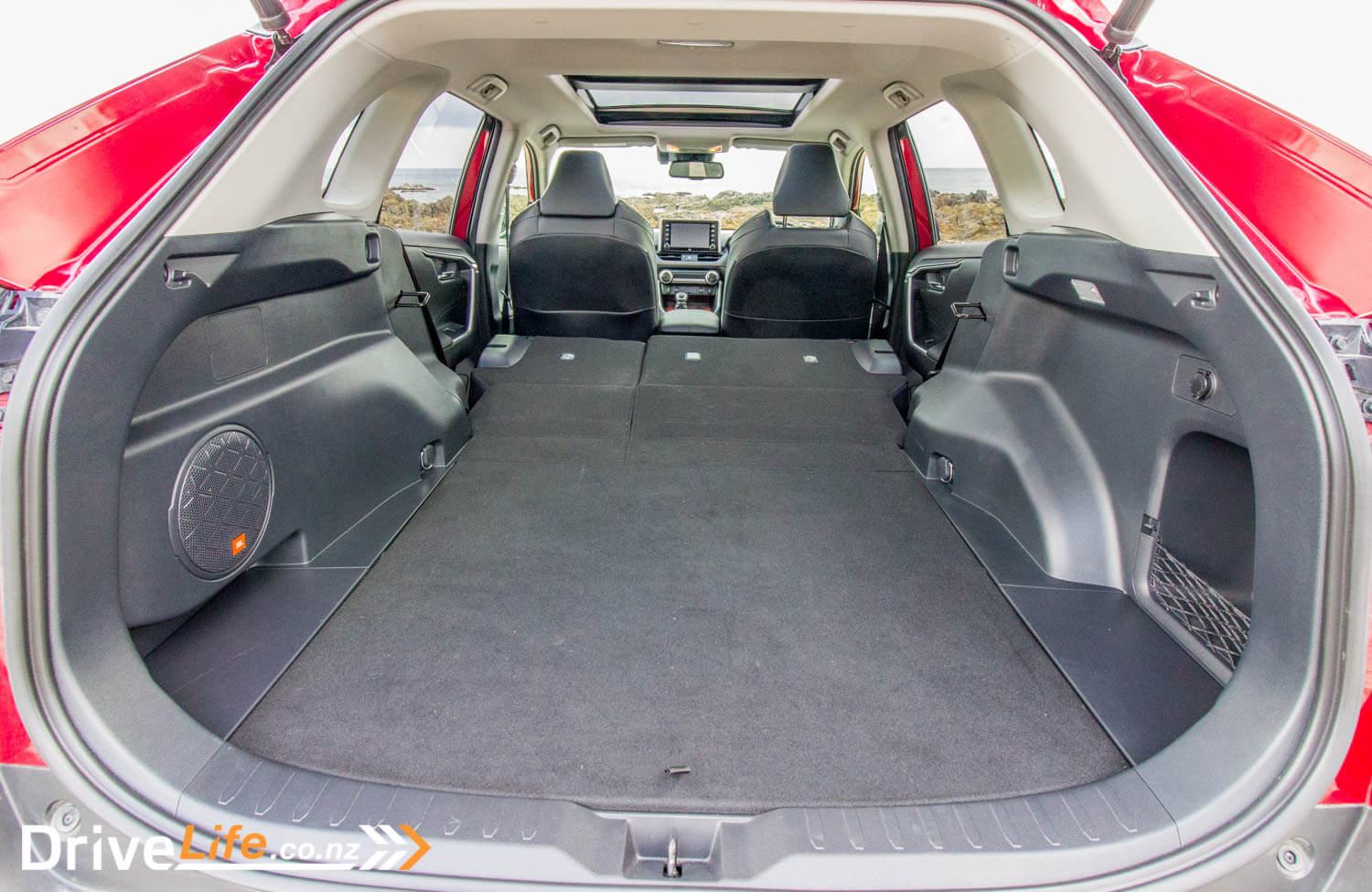
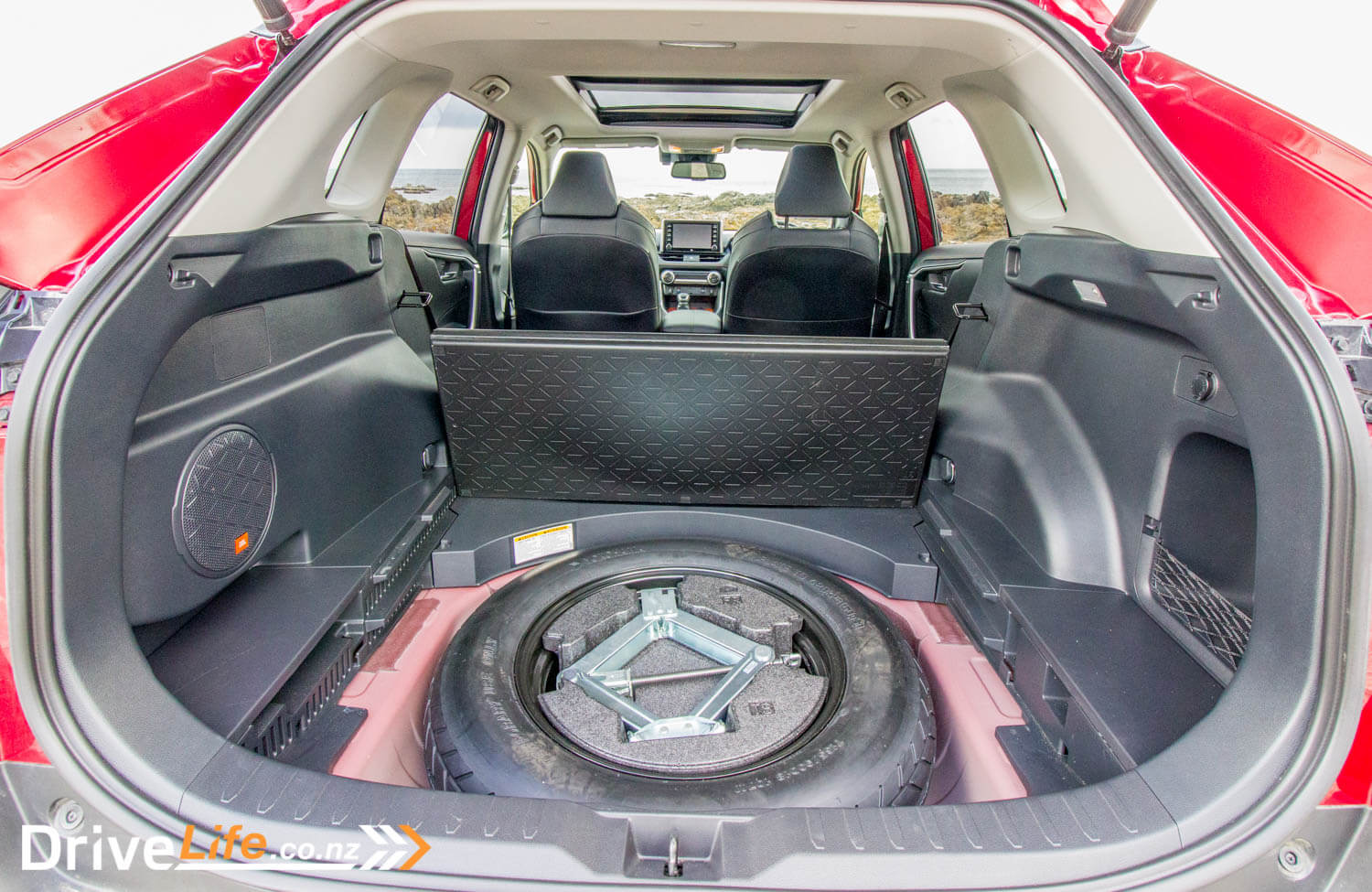
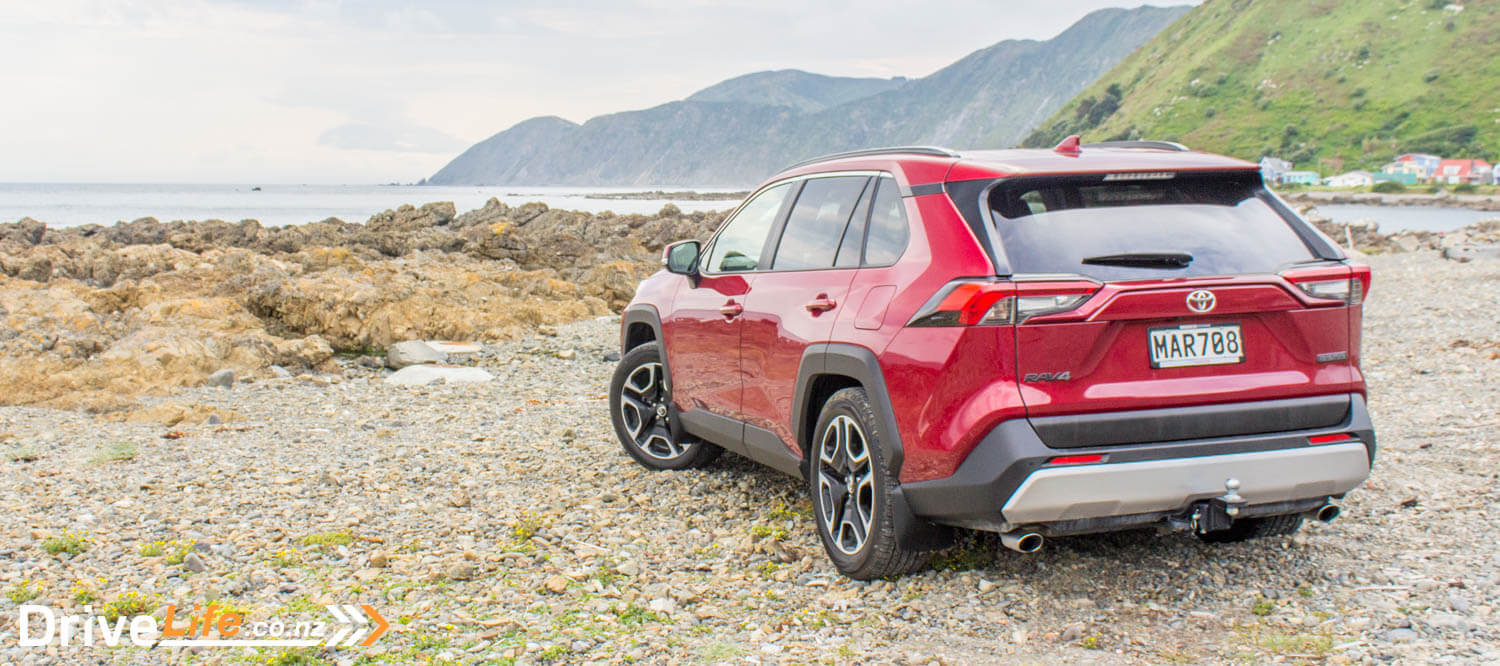



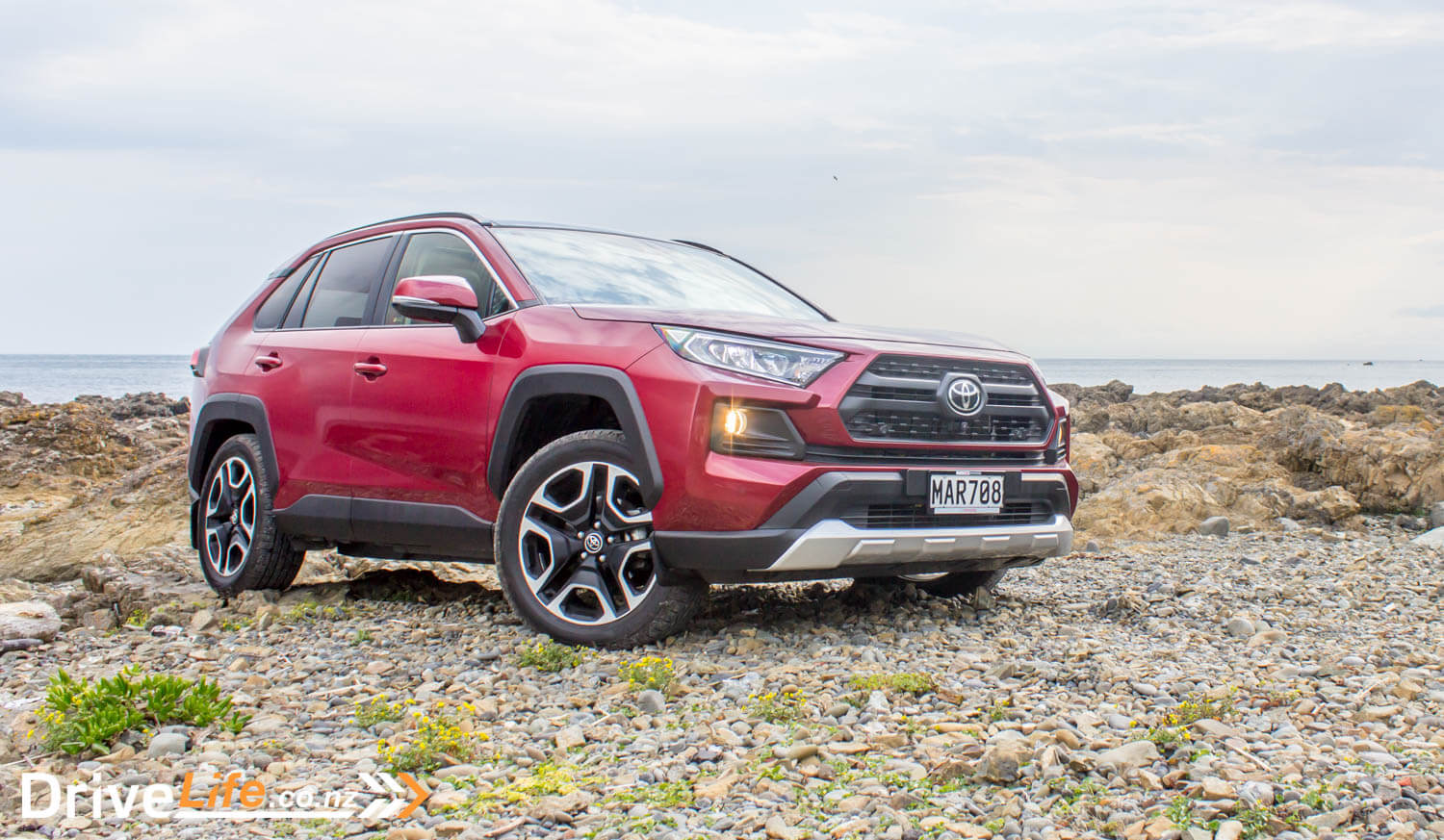











































Top of the line RAV4 has the sam price with Lexus RX350 ?
Hi Hung
The base model RX350 is $97k while the top spec RAV4 is $53K, so that’s quite a difference?
Cheers
Fred